Welcome to the home page of Duiker Hunting Safari’s. We cater for your every requirement And we endeavor to make bush hunting an unforgettable experience
Namibia the land of wide- open spaces is situated in the South- western part of the African Continent. In the west of the country lies the Namib Desert and the more north you go the more lush the country side becomes with temperatures between 5 C and 35 C from March to October.
Most of the hunting areas are situated in the North east of the country in the Grootfontein area – 70 000 acres and other concession in the central Mountain area Large numbers of Eland and Kudu is common in our Northern area. Other big game like Oryx, Zebra, Hartebeest, Blue wildebeest, Black Wildebeest, Impala, Springbuck, Blesbuck, Warthog, Duiker, Steenbok, Dik- Dik, Jackal, Baboon, Leopard, Giraffe, and most of the smaller species are available Large numbers of hunt able game birds like Guinea foul and doves is common.
DUIKER SAFARIS NAMIBIA
Duiker Safaris - the premier Namibia hunting outfitter is proud to offer the highest quality of plains game hunting, Leopard hunting in Namibia. We have over 20 plains game hunting species such as Kudu, Eland, Oryx to name a few. At Duiker Safaris, we take considerable pride in the manner in which we conduct our traditional African hunting safaris, as well as bow hunting safaris. Experience an hunting safari adventure of a lifetime.
ABOUT YOUR NAMIBIA HUNTING SAFARI
ur clients consistently leave with top quality trophies, in the 2003, 2004 and 2005 trophy hunting season several trophies in Namibia were taken at Duiker Safaris according to Namibia Professional Hunter Association (NAPHA). In the last few years, several of our hunting trophies reach NAPHA Gold Medal standards or higher, which is why so many of our clients have returned to hunt Namibia with us again and have sent their friends.
Every Namibia hunting safari is tailored to meet your specific desires with your unsurpassed satisfaction being our foremost priority. Each African hunt is adapted to provide choice and variety of safari hunting methods, including bow hunting safaris. According to your quarry, preliminary sighting may be done by 4x4 vehicle with closer approach on foot, stalking and tracking, waiting from several strategically located permanent blinds or from a makeshift hide as the plains game hunting necessitates. As a compliment to your game hunting safari, there may be an opportunity, depending upon the season, for some action packed wingshooting adventure..
NAMIBIA HUNTING SEASON
Our trophy hunting season in Namibia opens in February and runs through November, being 10 months long it incorporates each of the four seasons. There are no particular months when plains game hunting is necessarily better, but time constraints or personal considerations such as weather, touring, wingshooting, bow hunting or specific seasonal activities might make a certain period of time more desirable to you. Keep in mind while pondering your dates for hunting in Namibia, that seasons in Namibia, since we are in the Southern hemisphere are opposite of those in the Northern hemisphere.
YOUR NAMIBIA HUNTING SAFARI PROFESSIONAL HUNTING TEAM
We encourage you to contact a few of our clients as safari hunting references, there is no better way to gain confidence in Duiker Safaris reputation. Our safari hunting reference list will gladly be provided to you upon request, so that we may ensure the privacy of our clients.
FIRST PREPARATION OF YOUR HUNTING TROPHIES
With many years of experience refining their skills, our skinners working under the guidance of your Professional Hunter, will ensure that each of your hunting trophies is prepared to your specifications and treated with the exacting care it deserves. Once we have completed the first preparation of your hunting trophies, as soon as possible after your hunting safari your trophies will be personally delivered to our African animal taxidermist, who will disinfect, pack and crate your hunting trophies and deliver them to the consignor / shipping agent. Please note that you may choose to have your African taxidermy work done in Namibia, partially or fully, or you can have it sent to be done by your own taxidermist. We recommend that you bring to Namibia your taxidermist's contact information along with their trophy tags, which your taxidermist should easily be able to supply you with. African taxidermy prices will be emailed to you on request.
ARMS & AMMUNITION
While most shots are taken from within a 110 yards (100 meters), they can range from fairly close in thicker bush to relatively long distances up to 250 yards (230 meters) on open plains, so a good variable scope is suggested, you may also consider bringing a monopod or bipod. Any calibre .270 or higher may be used for most plains game hunting but we strongly recommend a .300 Magnum calibre rifle or higher. About 60 rounds of ammunition should be sufficient for a twelve- day hunt. We think it best that you bring some type of wearable rifle cartridge carrier. We recommend that clients bring their own rifle, although firearms and ammunition may be hired by prior arrangement For optimal performance, rifle sighting will be done prior to the commencement of your hunting safari.
CLIMATE IN NAMIBIA
In the central high plains of Namibia at an elevation of 5200 feet (1600 meter), the temperature range can be rather extreme, typically varying 35° F (20° C) between daily highs and lows. During the early and late months of the hunting season, the occasional rainstorm can disrupt the clear sunny skies; although there may be heavy showers they are usually short in duration and typically occur in the late afternoon or evening. In reality our climate is pleasantly low in humidity, the dry heat being much more tolerable and therefore more conducive to hunting than is the case in most other hunting destinations in Africa.
ACCOMMODATION & MEALS
Duiker Safaris hunting camp is a comfortable haven where you may relax with a cold beverage neatly prepared and served by our friendly staff, while pondering the fruits of a successful day on safari. Look forward to indulging in a variety of delectable meals featuring African game as well as more customary entrees, and coupled with fine South African wines. Followed by entertaining and memorable evenings spent in the company of your congenial Professional Hunter. A traditional Namibian barbeque (“braai”) may be enjoyed. Individually accommodated in one of our first- class bungalows, separate from the main ranch house, our guests will find their surroundings tastefully appointed with spacious bathrooms. We stock an assortment of soft drinks and fruit juices as well as local beers, wines and liquors. Our water is clean and safe to drink although bottled water is available upon request. For special dietary requirements, meal or beverage preferences will be catered to as best we can. Our trained house personnel also provide daily maid and laundry service.
HUNTING REFERENCES OF PAST CLIENTS
We encourage you to contact a few of our clients as safari hunting references, there is no better way to gain confidence in Duiker Hunting Safaris reputation. Our safari hunting reference list will gladly be provided to you upon request, so that we may ensure the privacy of our clients
HUNTING LICENSE
Once your hunting safari has been confirmed, Duiker Hunting Safaris will obtain your hunting permits on your behalf, which is part of our all inclusive pricing.
EXCURSIONS & TOURS IN NAMIBIA
Many of our hunters and their guests take the opportunity while in Namibia, usually following their hunting safari, to see more of our beautiful country. We would be happy to arrange an itinerary and guide your customized program, according to your interests and time availability, from half- day excursions to extensive tours of the country. Every detail will be taken care of during your all- inclusive private tour. All travel will be done in comfortable, reliable vehicles, although for some more remote destinations it may be preferable to charter an aircraft to save time (for an additional charge). Be assured, whatever the destination that we always provide our guests with the best accommodations and services available. Although the sightseeing opportunities in Namibia are too numerous to list, you will find a brief description below of our most popular destinations. Please contact us to discuss the many touring options available.
OUR TO ETOSHA NATIONAL PARK
A journey to Namibia would be incomplete without a visit to Etosha National Park, our most popular excursion destination and one of the world’s greatest game reserves. A one- day visit is possible due to the park’s close proximity to Duiker Hunting Safaris, leaving early in the morning, with an two and a half hour drive to the northern gate and returning later that evening. Although a two- day tour to Etosha, with an overnight stay at Okaukuejo , within the park, is preferable for those who wish to experience the night game viewing. At the floodlit waterhole, it is common to see Elephant, Black and White Rhinoceros, Lion, Leopard, Hyena or often- unseen nocturnal species. This huge sanctuary is home to over 100 mammal species including many rare and endangered animals and is some 8,598 square miles (22.270 km2) in extent with a network of 435 miles (700 km) of gravel roads. Please contact us for prices.
TOUR TO SWAKOPMUND
Visiting Swakopmund, a colonial German seaside town and Namibia’s premier holiday resort, is like stepping back in time. Not only will you be enchanted by its historic European charm, but delighted by the multitude of diverse points of interest to be explored within the immediately surroundings.
CLOTHES AND EQUIPMENT
Safari hunting wear should be comfortably fitting and made of a sturdy fabric, we suggest cotton in khaki or a neutral color. We recommend layering clothing since temperature changes throughout the day can be significant, typically varying 35° F (20° C) from day to night. It is essential that hunting boots be comfortable and well broken- in. Due to the thorn bush, we advise against wearing shorts for hunting. For your convenience laundry is done on a daily basis; packing should be done with this in mind..
- Casual clothing and shoes for evenings, leisure time and travel
- Underclothes
- Hunting boots
- Several pairs of long pants for hunting
- Variety of short and long sleeved shirts for hunting
- Warm sweaters
- A light jacket for wind or rain
- A warm jacket
- Gloves (functional for hunting)
- Hat for the sun
- Sunglasses
- Sun block with high SPF
- Lip balm with UV protection
- Bathing suit
- Flashlight and batteries
- Camera and film and/or video camera, tapes and charger
- Converter (220 to 110 volts)
- Binoculars
- Bag or pack for taking personal items on hunt
- Leather belt and ammunition pouch
- Firearm(s) and ammunition (see Arms & Ammunition section)
- Personal items, toiletries, eyeglasses, medications, etc.
In the unlikely event of an emergency, we have sophisticated medical services available in Grootfontein, 25 miles away. No inoculations are required to enter Namibia, although international travellers are generally advised to keep Hepatitis A vaccinations up to date. Malaria does occur in our arid region. Should you decide to take malaria medication, consult your doctor well before your departure. For current information visit the Center for Disease Control - Travellers' Health web site at http://www.cdc.gov/travel/safrica.htm.
Your final destination will be Windhoek International Airport, just outside the Capital of Namibia, where you will be met by us and taken by car (a 5 hour drive) to Duiker Hunting Safaris. Since there are no direct flights from any U.S. city to Namibia, there are basically two options available; flying to Namibia via South Africa or a major European city. Should you be travelling to or through South Africa, leaving the airport with your firearms, you will be required to fill out the new South Africa Firearms Permit Application Form.
You may wish to consider purchasing trip cancellation insurance, contact your insurance agent or try CSA Travel Protection Insurance at http://www.csatravelprotection.com or (800) 873.9855. Consider also insurance for your baggage, including your firearm(s), medical, 24 hour assistance..., from your travel agent or insurance agent (to compare and obtain prices online visit http://insuremytrip.com for your travel insurance plans from 14 different companies). Gracy Travel International of San Antonio, Texas, is a travel agency that specializes in sending hunters to Africa and around the world. You may
Lufthansa: http://www.lufthansa.com
South African Airways: http://www.flysaa.com
Air Namibia: http://www.airnamibia.com.na
contact them at (210) 698.2611, (800) 299.8558 or http://www.gracytravel.com.
ll foreigners must be in possession of a passport that will remain valid for at least six months after the intended date of departure from Namibia.
U.S. Department of State - Passport Services and Information http://travel.state.gov/passport_services.html
Citizens of the United States, Canada, France, Spain, Germany, Italy, Switzerland and United Kingdom planning to spend no more than 90 days in Namibia, with a return ticket, will be issued a visa at the airport upon arrival. Persons possessing passports from other countries may be required to obtain an entry visa prior to departure from their country. This should be done well in advance as it can take some time. You may check visa requirements for foreigners travelling to Namibia http://www.mfa.gov.na/frames/visasframe.htm.
BAGGAGE ALLOWANCE
Airlines at your departure point may be more liberal concerning baggage weight than airlines departing from Namibia; they are strict about total weight for checked baggage not being more than 44 lbs (20 kg) otherwise you may be charged hefty excess baggage fees. Gun weight should not be included in the calculation of total weight.
Private Bag 12029
Windhoek, Namibia
Tel (264) 61.221.601
Fax (264) 61.229.792
http://www.usembassy.namib.com
American Embassy in Namibia
1605 New Hampshire Avenue NW
Washington D.C. 20009, USA
Tel (202) 986.0540
Fax (202) 986.0443
Namibian Embassy in USA
Duiker Safari’s © 2023


Duiker Safaris
Contact information, related listings.

JFG Tours and Safaris CC
- +264 811 273 365

Waagenaar Wildlife Safaris cc
- +264 813 014 202

Kungula Big Game safaris Cc
- +264 61 264 207
- [email protected]

Mvuvhu Hunting Safaris CC
- Activities Adventures and Tours
- Art Culture and Tourist Attractions
- Industry News
- Namibia at a Glance
- National Parks
- Top Destinations
- Unique to Namibia
- World Heritage Sites
NTB Newsletter
Signup to our newsletter.
This will close in 0 seconds
Privacy Overview

Incredible Landscapes, Unsurpassed Game Selection & Professional Hunter Interaction
Why hunt anywhere else.

omatako_hunting_safari_namibia_gallery_2

omatako_hunting_safari_namibia_gallery_6

omatako_hunting_safari_namibia_gallery_1

omatako_hunting_safari_namibia_gallery_9

omatako_hunting_safari_namibia_gallery_15

omatako_hunting_ranch_namibia_2

omatako_hunting_ranch_namibia

omatako_hunting_safari_namibia_gallery_4
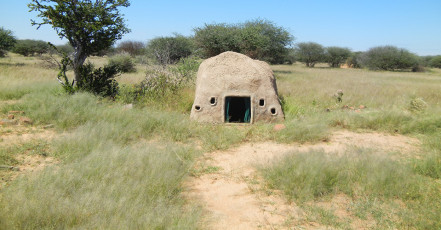
omatako_hunting_ranch_namibia_3

omatako_hunting_safari_namibia_gallery_16

omatako_hunting_safari_namibia_gallery_10

omatako_hunting_safari_namibia_gallery_13

omatako_hunting_safari_namibia_gallery

omatako_hunting_safari_namibia_gallery_14

omatako_hunting_safari_namibia_gallery_8

omatako_hunting_safari_namibia_gallery_5

omatako_hunting_safari_namibia_gallery_7
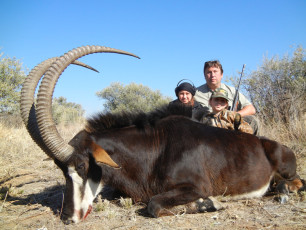
omatako_hunting_safari_namibia_gallery_12

omatako_hunting_safari_namibia_gallery_3

omatako_hunting_safari_namibia_gallery_11

More Than a Hunting Lodge
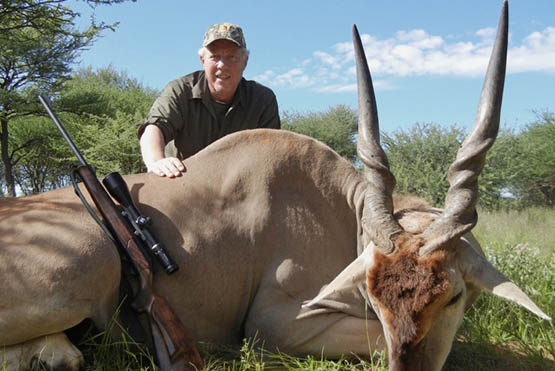
- Hunting Safaris
One of the reasons why so many people choose to hunt with Omatako Hunting Trails is that one stays within the picturesque setting of the actual hunting area, which saves an enormous amount of travel time.
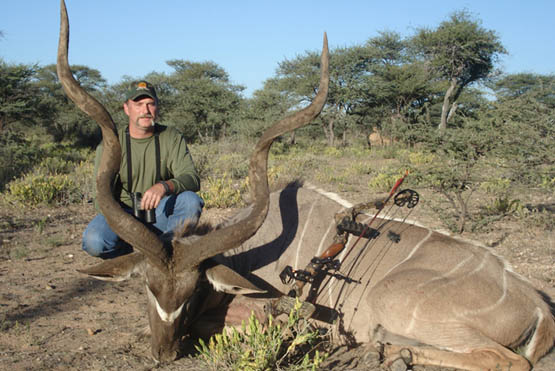
- Bow Hunting
Omatako Hunting Trails not only specializes in Rifle Hunting but also in Bow Hunting. Proud to offer the dedicated bow hunter some of the best bow hunting experience that Africa and Namibia has to offer.

Accommodation
Accommodation at Omatako Hunting Lodge consists of 6 luxury thatched bungalows – each is designed to have an unobstructed view of the vast open plains where one can enjoy watching animals at the waterhole.
We listen to your needs and tailor a package suited for you.
leopard hunting, omatako hunting trails offers just two exclusive leopard hunting safaris each year, and has a high success rate..
- Email * Enter Email Confirm Email
- Country of Origin * -- Afghanistan Albania Algeria American Samoa Andorra Angola Antigua and Barbuda Argentina Armenia Australia Austria Azerbaijan Bahamas Bahrain Bangladesh Barbados Belarus Belgium Belize Benin Bermuda Bhutan Bolivia Bosnia and Herzegovina Botswana Brazil Brunei Bulgaria Burkina Faso Burundi Cambodia Cameroon Canada Cape Verde Cayman Islands Central African Republic Chad Chile China Colombia Comoros Congo, Democratic Republic of the Congo, Republic of the Costa Rica Côte d'Ivoire Croatia Cuba Curaçao Cyprus Czech Republic Denmark Djibouti Dominica Dominican Republic East Timor Ecuador Egypt El Salvador Equatorial Guinea Eritrea Estonia Ethiopia Faroe Islands Fiji Finland France French Polynesia Gabon Gambia Georgia Germany Ghana Greece Greenland Grenada Guam Guatemala Guinea Guinea-Bissau Guyana Haiti Honduras Hong Kong Hungary Iceland India Indonesia Iran Iraq Ireland Israel Italy Jamaica Japan Jordan Kazakhstan Kenya Kiribati North Korea South Korea Kosovo Kuwait Kyrgyzstan Laos Latvia Lebanon Lesotho Liberia Libya Liechtenstein Lithuania Luxembourg Macedonia Madagascar Malawi Malaysia Maldives Mali Malta Marshall Islands Mauritania Mauritius Mexico Micronesia Moldova Monaco Mongolia Montenegro Morocco Mozambique Myanmar Namibia Nauru Nepal Netherlands New Zealand Nicaragua Niger Nigeria Northern Mariana Islands Norway Oman Pakistan Palau Palestine, State of Panama Papua New Guinea Paraguay Peru Philippines Poland Portugal Puerto Rico Qatar Romania Russia Rwanda Saint Kitts and Nevis Saint Lucia Saint Vincent and the Grenadines Saint Martin Samoa San Marino Sao Tome and Principe Saudi Arabia Senegal Serbia Seychelles Sierra Leone Singapore Sint Maarten Slovakia Slovenia Solomon Islands Somalia South Africa Spain Sri Lanka Sudan Sudan, South Suriname Swaziland Sweden Switzerland Syria Taiwan Tajikistan Tanzania Thailand Togo Tonga Trinidad and Tobago Tunisia Turkey Turkmenistan Tuvalu Uganda Ukraine United Arab Emirates United Kingdom United States Uruguay Uzbekistan Vanuatu Vatican City Venezuela Vietnam Virgin Islands, British Virgin Islands, U.S. Yemen Zambia Zimbabwe
- Leopard Hunting
Please note that any enquiries sent through the form below are for informational purposes only and does not constitute a confirmed booking.
Our hunting partners.

@omatako_hunting_trails_namibia

21° 32’ 42.53” S | 16° 47’ 41.54” E P.O. Box 290, Okahandja, Namibia E-mail: [email protected]

- Travel & Tourism
- Trophy Shipment
- Testimonials
- Accommodation at Omatako
- Special Package
- Request A Price List
Privacy Overview
Please complete the form and we’ll email you a full price list.

- [email protected]
- +264 (0) 67 290 175
- P.O.Box 81 Kalkfeld, Namibia
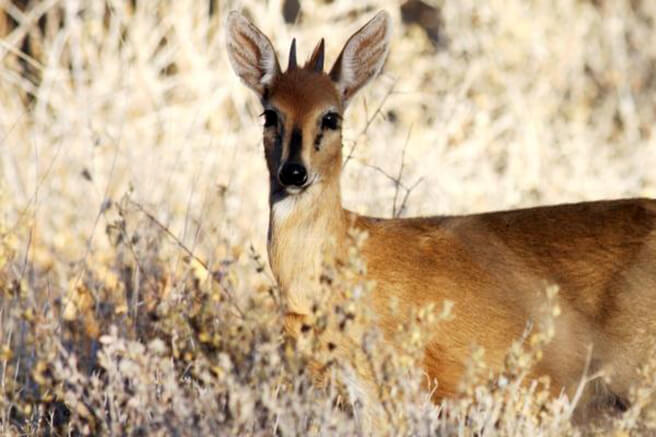
The Duiker are the biggest of Namibia's "small 4" antelope. This includes (from smallest to largest) the Dik-dik, Steenbuck, Klipspringer and Duiker.
Duikers lives in pairs, and are most easily distinguished from the Steenbuck by their greyish colour and black stripe down the face.
Duikers occur in the thicker bushed areas as well as along all the numerous riverines in the area.
Only the males have horns with a average size of 4 inches
- PRICING & DEALS
- LINKS & PARTNERS
- Black Wildebeest
- Blue Wildebeest
- Burchell’s Zebra
- Cape Buffalo
- Damara Dik-Dik
- Gemsbok (Oryx)
- Hartmann’s Mountain Zebra
- Klipspringer
- Red Hartebeest
- Namibia Wingshooting
- Testimonials
- Kalahari Hunting Camp
- Kalahari Hunting Lodge
- Tholo Camp Hunting Lodge
- Khomas Hochland Camp
- Namibia Travel Info
- Sightseeing Activities
- Meet The Team
- Links, Partners and Associates
A tiny, shy antelope.
Duiker can live independently of water and feed on leaves, fruit and seeds. they are one of the very few antelope to have been known to eat insects and carrion..
The common, or grey, Duiker is a tiny, shy antelope with only the males having short horns. The common name refers to a characteristic habit of taking off at high speed in a series of diving jumps when alarmed.
Duiker browse a wide range of broad-leaved forbs, trees and bushes, they also eat fruit, pods and seeds, roots, bark, flowers, fungi, caterpillars and even nestling birds. In arid areas wild melons are eaten for their water content. Duiker can become a problem in crops, orchards, vineyards and plantations.
Duiker do not live in forests, although they will take refuge in forests when hiding from a predator. Duiker are w idely distributed in Southern Africa, but absent from desert regions. The Common Duiker is usually seen at dawn and dusk in open scrub country. They avoid open grassland where there is no shelter.
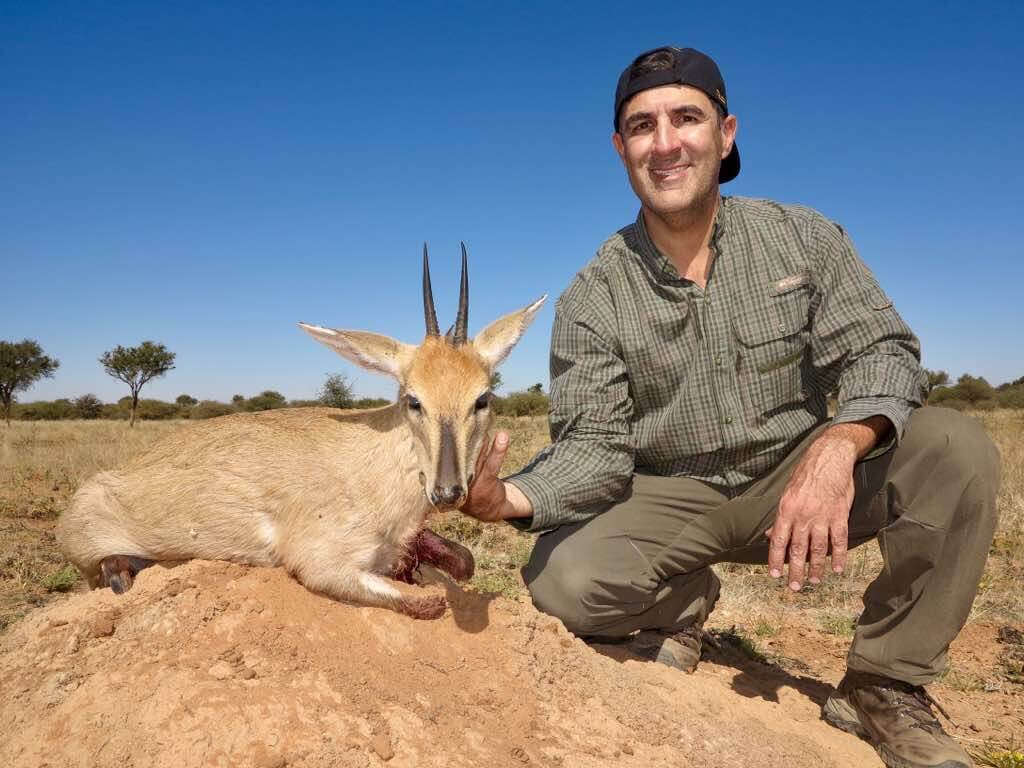
Hunting The Duiker
...a few things to know.
Adult male Duiker stand 500mm at the shoulders and females are about 20mm higher. Males have a mass of between 15-18kg, females will be between 16-21kg.
The colour of the upper parts varies from greyish-buff to a reddish-yellow and considerable colour variation within Duiker populations can be observed in some areas. The under parts are usually white. Most Duiker have a black band restricted to the lower part of the face near the nostrils.
Ready to inquire about this hunt? Click this button, get in touch and we'll help you start planning your amazing African safari hunt!

©2019 Schalk Pienaar Safaris Namibia. All rights reserved.

- Privacy Policy
- Terms of Use
BOOKYOURHUNT
Duiker hunting in Namibia
Duiker antelope hunting in namibia.
A mature trophy is considered to be a male duiker “past its prime” .
Minimum caliber:
.243 (or equivalent in mm) / 1350 joules
Did you know?
Duiker are water independent and can get their liquid through bushes and fruits. A very crazy fact is that the small antelope even eats nestling ground birds, reptiles and even mice.

Indigenous to Namibia
Historical habitat range is countrywide, except in the desert areas
- Only the males wear horns
- If the “ornament ring-section” can be seen above the frontal hairs, it is a mature trophy
- If the horns are a few centimeters higher than the tips of the ears
Trophy fees including hunting license:
Between 400 – 590 €
+ Raw treatment:
Cleaning, bleaching & pickling: From 40 € per animal or group price from 300€ all-inclusive.
+ Preparation, e.g.:
Shoulder mounting: From 390 €
Skull on board: From 85 €
Skin: From 110 €
+ shipping & handling:
depending on preparation, shipping method and weight
Note: All prices are indicative and vary from supplier and farm to farm depending on population size and demand.
- They are common across Namibia
- They are perfectly adapted to savannah and desert areas as well as shrub & grasslands
- They are often found in thickets, so a duiker is usually hunted at close range
- Are most active in the early morning and late afternoon
- Duiker are solitary animals
- The best chance to hunt a mature duiker is while stalking.
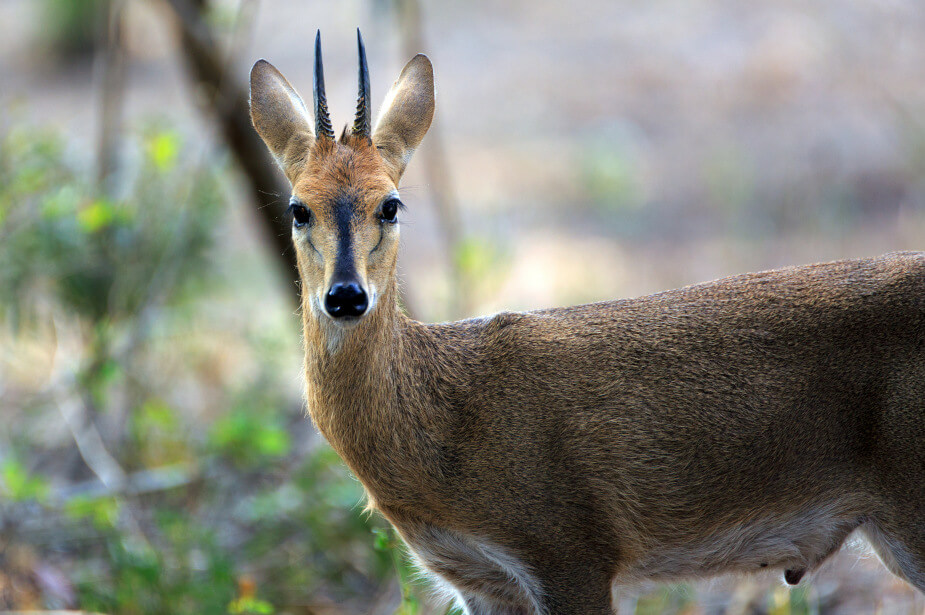
Indigenous & unfenced
Discover all hunting farms with a high free-range population of duiker antelope.
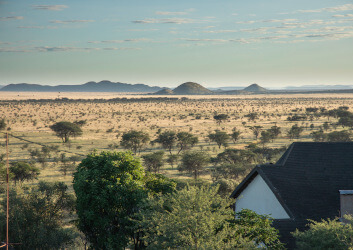
Khomas hunting farm #3
✓ perfect for two hunters ✓ hunting experience in the fascinating Kalahari foothills with vast savannah areas in the midst of rolling hill ranges ✓ rustic farmhouse style or adventure wildcamping possible
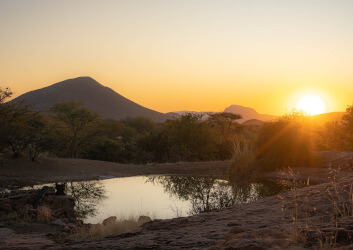
Erongo hunting farm #4
✓ perfect for small groups & families ✓ outstanding cuisine made from ingredients harvested on site ✓ comfortable farmhouse style with pool ✓ great biodiversity in open savannah areas and rugged mountains
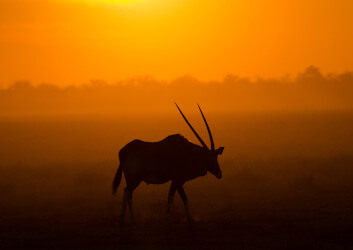
Khomas hunting farm #6
✓ perfect for a maximum of two hunters incl. accompanying persons or families ✓ special combination possibility of hunting on the farm area AND exclusive concession areas ✓ accommodation in apartments or fully equipped safari tents
Discover which indigenous, free-roaming game species are found in Namibia
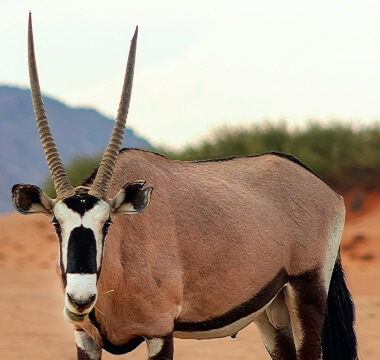
This hunting guide will help you make the right decision for your hunting trip. Need more information?
All reviews of 'Duiker Safaris' (8)

Review score Based on 8 reviews
Excellent hunting experience
Great hunts in namibia.
I have hunted there 3 times over the last few years. I was very impressed with the accommodations, hunting, animals harvested, and especially the people. I also would recommend taking the trip with Benny to hunt with Nico for Mountain Zebra and other animals if desired.
Much more than was expected.
Not one thing.
Very personable
Everything, excellent (people,food,animals,country,guiding,tracking, trophy care. You name it, it was all top notch!
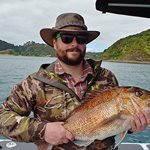
The best hunting experience of my life
I knew this was going to be a great experience for my father and I when the entire family came out to greet us as we arrived at the farm. From day one we were treated like family even though we had only just met. Fantastic family meals, wonderful accommodation, outstanding guide service and an incredible amount of high-quality game all at a very affordable price. I was fortunate to take a total of 6 animals over 5 days, including 4 in a single day and 2 of those within 5 minutes of eachother in the same field! The moment we left I was already planning our next visit. Look no further because you have found the ultimate African hunting experience.
There was absolutely nothing negative.
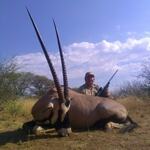
The owners and guide very professional
I like the hunt, difficult but very interesting, and the nice family and the welcoming of the owner , nice trip
Hunting experience
The experience of tracking eland with Bushman trackers exceeded my expectations.
Erwartungen übertroffen
Eine sensationelle Jagderfahrung mit Bennie Boshoff auf Eland, Gnu und Springbock. Ehrliche anspruchsvolle Pirsch auf spannendes Wild. Kompetenter und geduldiger PH. Gastfreundlichkeit und exzellente Bewirtung. Ich komme wieder.
Abschied behmen.
Accomodation and hospitality
Professional hunters / staff
Game quality
Value for money
{{ $ctrl.data.title }}
Duiker Hunting Safari in Namibia Sylvicapra grimmia

Native to sub-Saharan Africa, the duiker is an antelope that is relatively small in size compared with other African buck. Forest-dwelling duiker inhabit the rainforests of sub-Saharan Africa, but the bush duiker is of particular interest to us as it occupies savannas and open grassland.
The smallest of the species is the blue duiker, which usually reaches a maximum weight of five kilograms. Other types, such as the common or grey duiker, range from an adult weight of 16-20 kilograms, with females weighing more than the males. Only male duikers grow horns, and these are usually about 11cm long.
Duikers are very shy and independent in nature - they are especially skittish in open grassland. When threatened they may freeze or dash into a bush – their long legs allow them to run fast and for long distances.
Their activity is varied, some are diurnal, and some are nocturnal – it just depends on the distribution of food in the area and the variety, as a duiker will eat what is available. Duikers enjoy grazing for seeds, leaves, shoots and fruit, but will also eat small rodents or birds when needed. They can go for very long periods without water, so can often be found in locations where water sources are scarce.
Join us for our next duiker hunting trip. Our all-inclusive hunting packages offer an ethical, authentic and personal experience.
.png)
Common Duiker
Common Duiker are small, elusive antelopes found in the forests and savannas of Africa. They have a distinctive reddish-brown coat, with white underparts and legs. Common duikers are known for their agility and speed, and they are able to move quickly through dense vegetation. They feed on leaves, fruits, and shoots of low-lying vegetation.
with Craig Boddington?
Join one of our top outfitters for a common duiker hunt and experience the thrill of tracking and harvesting these elusive antelopes. Our experienced guides will take you to the best hunting grounds where you will have the opportunity to experience a successful and memorable hunt. Book your hunt now and take advantage of the best opportunities for a thrilling adventure.
Endorsed Outfitters that hunt

The game farm situated in the Magaliesburg – named Battle Creek – is aptly named with a history of being part of the many battlefields for soldiers colliding. On what used to be President Paul Kruger’s private hunting farm, this area has old forts and ruins that can still be seen scattered around the property today.
Roche Safaris is a family run outfit operating in the Mpumalanga Province of South Africa and Mozambique. With over 70000 acres of pristine game land he provides the perfect hunting grounds for top quality animals.

Dirk de Bod and his Safaris Namibia are that rare entity in today’s Africa: A well-known name, but still a small outfit that retains the personal touch.
.jpeg)
Jaco and his team of professional hunters and staff will ensure that you will enjoy the most memorable time of your life in wild Africa, tracking, stalking, and giving adrenaline-pumping opportunities, and creating life-long friendships around heart-warming campfires. Hunt with GAME TRACKERS AFRICA! Live the African Legacy.

Carl van Zyl and his team at John X Safaris are a real class act! They're a second generation outfit based in the East Cape, South Africa, specializing in both plains and dangerous game, with a superb Cape Buffalo hunt at their base Woodlands Safari Estate.

For more than two decades, African Echo Safaris grew into a successful and internationally recognised hunting safari covering most of Southern, Eastern and Western Africa.
.jpg)
Jamy Traut is a well-know and respected outfitter based in Namibia. Jamy Traut Hunting Safaris is a family-run operation dedicated to providing a small number of clients with an unequaled opportunity to hunt Africa's great game.

Family owned and operated. Burchell Private Game Reserve in South Africa is privately owned land and it is exclusively for our clients.

K&K Premium Hunting - Your partner for exclusive hunting tours and safaris worldwide

At Eland Safaris, you'll find an oasis in the African bushveld. A family-owned and operated company. Alex & Johnny Thomson with their wives Tamryn and Janeske as well as the professional hunters and staff, will not only ensure your safety, but also share their knowledge of this rich and diverse habitat.

J.P. Kleinhans offers excellent concessions in the Eastern Cape and elsewhere in South Africa, offering a tremendous range of game. Africa has many extremely competent outfitters and professional hunters. J.P. is certainly among them, but few make it as much fun! If you like to laugh, you’ll love hunting with J.P. Kleinhans!
In which countries can you hunt this species?

Which are the best months to hunt this species?
Frequently asked questions, what sets common duiker hunting apart from other pursuits.
Hunting Common Duiker is a unique game for the discerning hunter. These small, elusive antelopes, often called "grey ghosts" of the African bush, present an intricate hunting challenge, making them a prime choice for serious hunters who appreciate subtlety and skill in their hunting experiences.
Where does Craig Boddington Endorsed Outfitters recommend for prime Common Duiker hunting?
Craig Boddington Endorsed Outfitters predominantly suggests regions in Central and Southern Africa for Common Duiker hunts. These regions are rich in biodiversity and offer ideal habitats where Duikers thrive, ensuring a genuine and immersive hunting experience.
What's the best time to embark on a Common Duiker hunt with CBEO?
Though Common Duikers can be sought throughout the year, the drier months, when vegetation is less dense, provide better visibility and heightened chances of spotting these elusive creatures. CBEO organizes these hunts keeping in mind the optimal conditions for serious hunters.
For those serious about hunting Common Duiker, what gear is recommended?
The gear that enhances a Common Duiker hunt includes:
- A rifle of .243 caliber or similar for precise shots
- Binoculars with high-definition clarity
- Camouflage attire suitable for bushveld terrain, ensuring seamless blending
Can I couple a Common Duiker hunt with other game hunts?
Absolutely! With Craig Boddington Endorsed Outfitters, you can merge a Common Duiker hunt with pursuits of other African game, enriching the overall experience for serious hunters looking for varied adventures.
What should one anticipate in terms of physical demand during a Common Duiker hunt?
Given the Duiker's elusive nature, expect a fair amount of walking and stalking. While the hunt is adaptable to various fitness levels, a moderate physical condition can enhance the overall experience.
Why opt for CBEO for your Common Duiker hunting expedition?
Craig Boddington Endorsed Outfitters embodies a legacy of premier hunting experiences. When serious hunters opt for CBEO, they're choosing unparalleled expertise, dedication to sustainable practices, and a memorable hunting journey.
How does CBEO cater to the aspirations of serious hunters targeting Common Duiker?
At CBEO, we recognize the intricate nature of Common Duiker hunting and tailor the experience to meet the specific desires of serious hunters. Every hunt is a careful blend of challenge, tradition, and respect for the game, ensuring it's not just a pursuit but an unforgettable story.
The CBEO Experience
At Craig Boddington Endorsed Outfitters, we value transparency, integrity, and the absolute best in hunting experiences. We believe that each hunt is more than just a price tag - it's a personalized journey for every hunter while we cannot list specific prices like the impersonal hunting directories out there you may have seen, we want to emphasize that we hand-pick outfitters known for their impeccable service, expert knowledge, and fair pricing. We understand that a hunt is an investment and we are committed to ensuring our clients get the best possible return - in experience, satisfaction, and the thrill of the hunt.
- Endorsement by Craig Boddington, a hunting legend with over four decades of experience in outdoor journalism, is a testament to the quality and reliability of the hunting outfitter.
- Our boots on the ground vetting means each endorsed outfitter is ensured to offer top-notch, expert knowledge, and a high standard of animal welfare and conservation.
- Craig's endorsement are not influenced by sponsorships or partnerships. They are solely based on Craig's honest, personal experience and assessment.
- Craig's endorsement outfitters understand that pricing is more than just a cost - it's the value you receive from a meticulously planned and executed hunt.
- We connect you with the outfitter directly for pricing and details. This ensures a personalized service tailored to your specific needs and expectations.
- We ensure that all pricing is fair, competitive, and representative of the top-tier service offered by our endorsed outfitters.
- By dealing directly with the outfitter, you avoid any third-party fees or commissions.
- We are not a booking agency and accept no commissions. This means there is NO MARKUP on your hunt.


Donkerhuk West
Just below the Khomas-Highland Escarpment, nestled in a Valley bordered by Granite Mountains, and about halfway between Swakopmund and Windhoek along the C28 Gravel road, you will find Farm Donkerhuk West. A family-owned farm covering an area of 7614 hectares, offering two Exclusive Campsites ( Andi’s Camp and the new “ Duiker’s Den “) and three Luxury Self-catering Tents ( Barbarossa Tented Camp ) for visitors.
Breath-taking Landscapes invite you to various activities such as Hiking, Mountain biking, guided or self-drive Farm Drives and Night Drives, or just to relax in your camp of choice. Historical indigenous sites, artifacts and Rock Paintings, as well as remnants from the colonial era and an old mine shaft from the 1960’s can be visited during your stay with us. Although Game is not abundant here, Oryx, Mountain Zebra, Giraffe, Warthog, Klipspringer, Kudu and Springbuck, to name a few, can at times be spotted by a keen eye during farm drives and hikes. Among the nocturnal species that might be spotted on night drives, are Springhare, Aardwolf, Bat-eared Foxes and Silver Fox, with African Wildcat, Porcupine, Honey Badger, Aardvark, Striped Polecat, Small-spotted Genet, Caracal, Brown and Spotted Hyena as well as Leopard being an absolute rare bonus when spotted.

Duiker's Den

Barbarossa Tented Camp

Andi's Camp

Lieber Chris, Leider haben wir Dich nicht mehr angetroffen, aber wir möchten uns auf diesem Wege nochmal ganz herzlich für Deine Gastfreundschaft bedanken. Die Farm ist wunderschön und wir haben es sehr genossen so auf eigene Faust erkunden zu dürfen. Wir wünschen Dir das Beste und sind uns einig welche Farm wir zuerst ansteuern werden, wenn wir wieder nach Namibia kommen. God bless you.
Katharina & Matthias

07/06/2019. Eine wunderschöne Nacht in herrlicher Stille und mit schönstem Naturschauspiel! Es war alles vorhanden, was man benötigt und wir haben uns mehr als wohl gefühlt. Schade, daß wir weiter reisen müssen, sonst würden wir sicherlich gerne noch an diesem wundervollem Ort verweilen. Vielen Dank
Markus & Jana

Donkerhuk, what a great camping spot! Friendly owner, lots of shade, clean toilets and showers, relaxing weekend with good friends. Would highly recommend! We live in Swakopmund, and the drive there is beautiful, road graded recently, and not too far. Thanks Chris!

War ein toller Tag bei Dir mit einem Essen, was man in Namibia in keinem Restaurant bekommen kann - einfach super! Herzlichen Gruß.
Klaus und Bärbel

Lieber Chris Familie Wiedenroth, Roesener, Kubirske und Michi mit Juri, bedanken sich für das tolle Wochenende. Eine super Anlage und Campingplatz! Alter Schwede, Lekka! Wir kommen wieder! Chris, Danke Dir!!!
Paul und Jörn

Lieber Chris, Nach einer tollen Woche im Süden ist dieses Camp unser Abschluss. Herrlich unter den Bäumen, ein Bierchen (oder drei) mit dir am Feuer. Wirklich schön angelegt und wirklich luxeriöse Badezimmer! Danke Dir, wir freuen uns auf Juli, dann lassen wir es krachen!
Die Heiser – Schmidt-Gebauer Kolone

Andi’s Camp ist ganz schön angelegt, wir haben die natürliche Athmosphäre hier im Revier unter den Bäumen sehr genossen. Super das die Hunde mit durften. Die Toiletten wurden auch geschätzt. Herlichen Dank!
Güther’s Pacholski, Johannes

Lieber Chris, Wir hatten unseren letzten Camp-Tag auf Eurem Fleck Erde verbracht. Traumhaft, ein eigenes Tal... Wir haben es genossen! Danke!
Steffen und Familie

Bush Duiker
Sylvicapra grimmia.
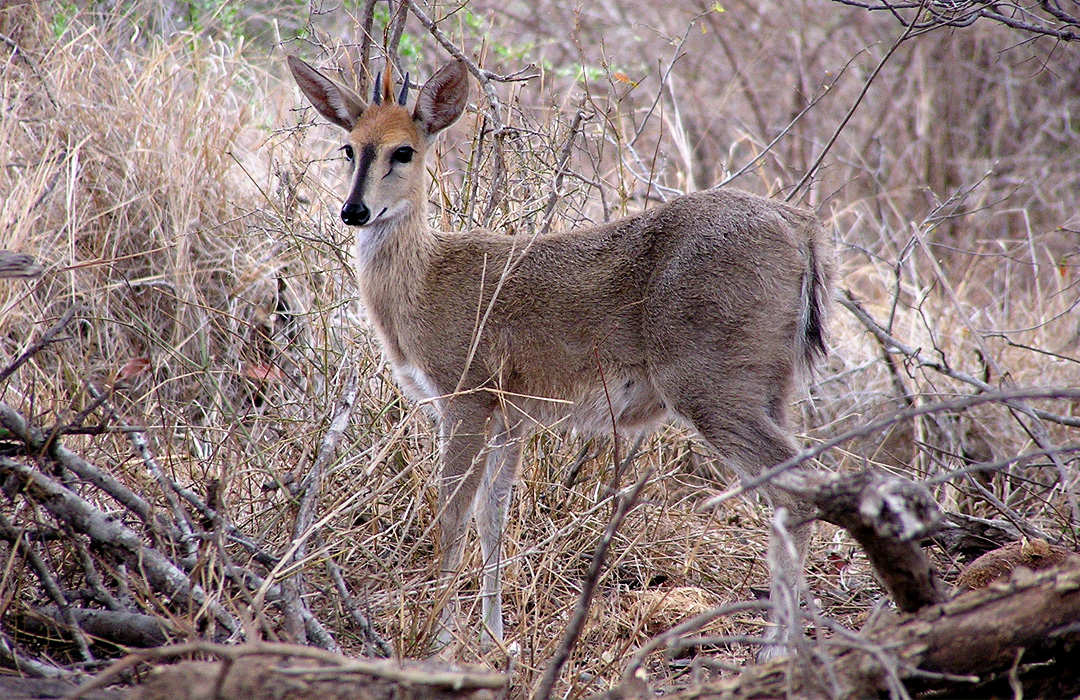
The average weights, coloration, and ear size of the gray or common duiker vary with geographic location. Females generally weigh 2-4 kg more than males in a given region. On average, they are 60 cm in height at the shoulder and are 100 cm in length. Males have horns, which are spikes 7-18 cm and are heavily grooved at the base. Females usually do not have horns, but occasionally they may have stunted horns.
Mass: 12 to 25 kg; avg. 18.50 kg (26.4 to 55 lbs; avg. 40.7 lbs)
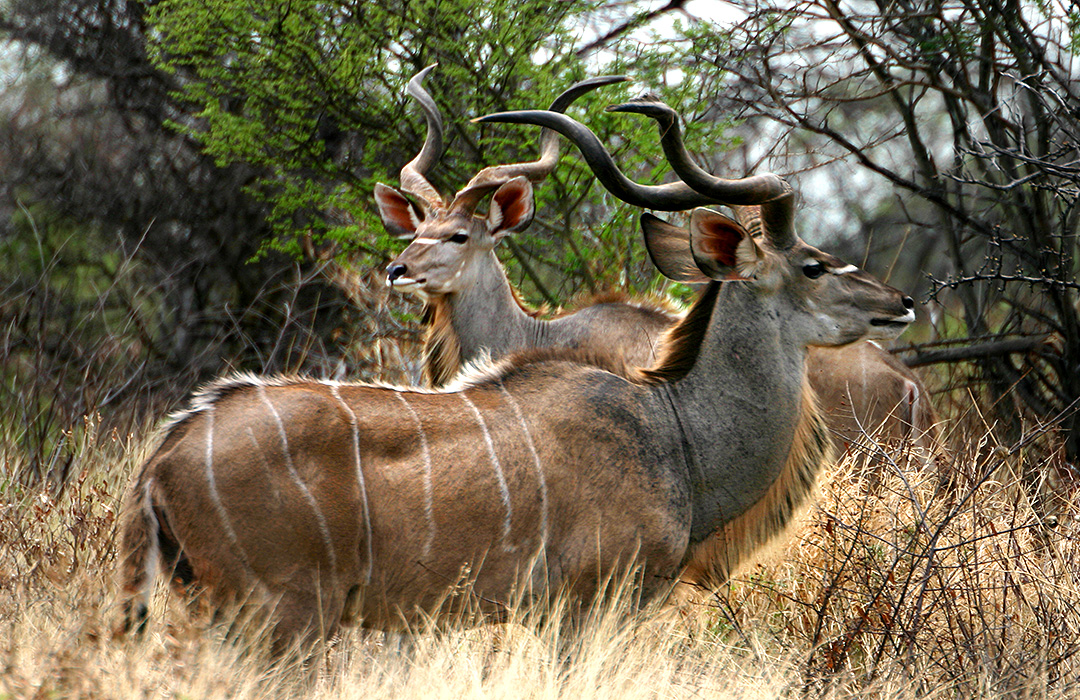
Greater Kudu
Greater kudu are one of the tallest antelopes, with shoulder heights ranging from 100 cm to 150 cm. Greater kudus have the largest horns in the bushbuck tribe, averaging 120 cm in length.
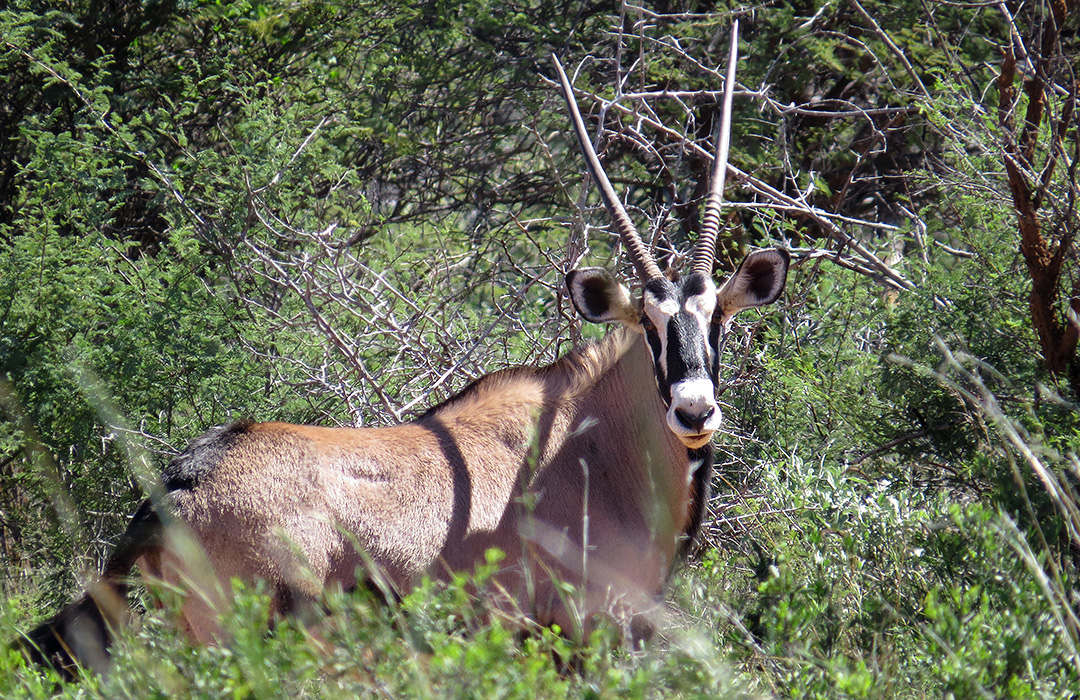
Gemsbok (Oryx)
Gemsbok are large bovids with very thick, muscular necks, covered in dense, inelastic skin. Oryx gazella is the largest of the Oryx species.
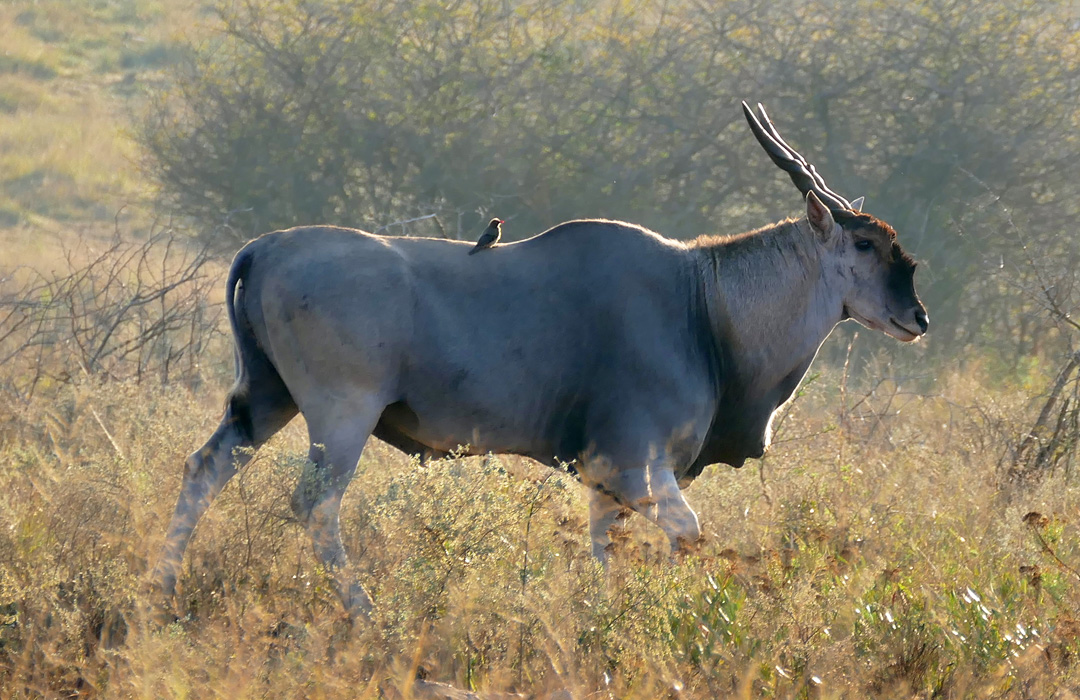
Eland males are much larger than females, weighing 400-1000 kg compared to 300-600 kg for females. Hides are a uniform fawn color with some vertical white striping on the upper parts.
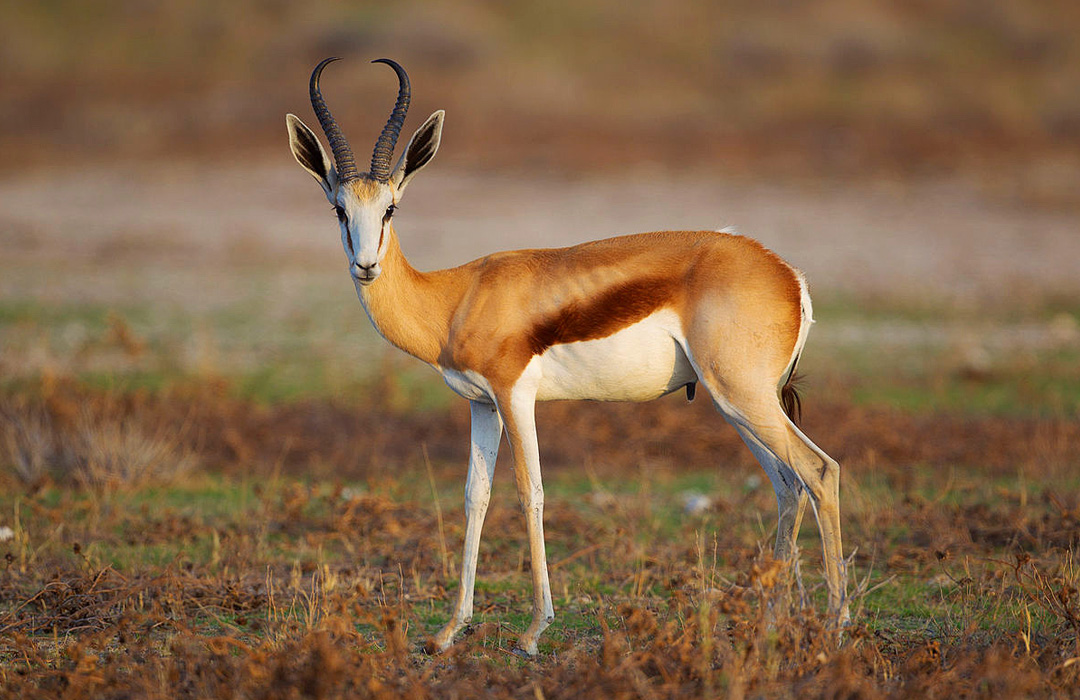
The springbok is a strikingly marked, gazellelike antelope. It has a white face with dark stripes from the mouth to the eyes, a reddish-brown coat that turns to a darker shade and then to white on the lower third of its body, and a white backside.
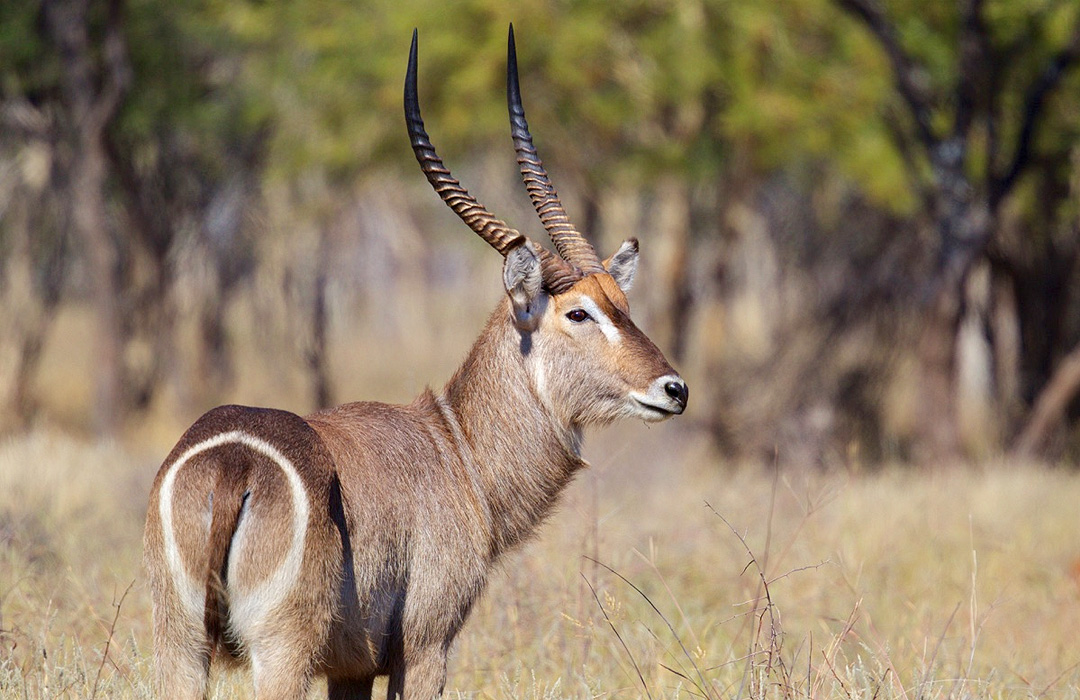
Waterbuck have long bodies and necks and short legs. The hair is coarse, and they have a mane on their necks.

Impala are sexually dimorphic. In this species only the males have S shaped horns that are 45 to 91.7 cm long. These horns are heavily ridged, thin, and the tips lie far apart.

Giraffa camelopardalis is the world’s tallest mammal. Male giraffes (bulls) stand a total of 5.7 m from the ground to their horns: 3.3 m at the shoulders with a long neck of 2.4 m.
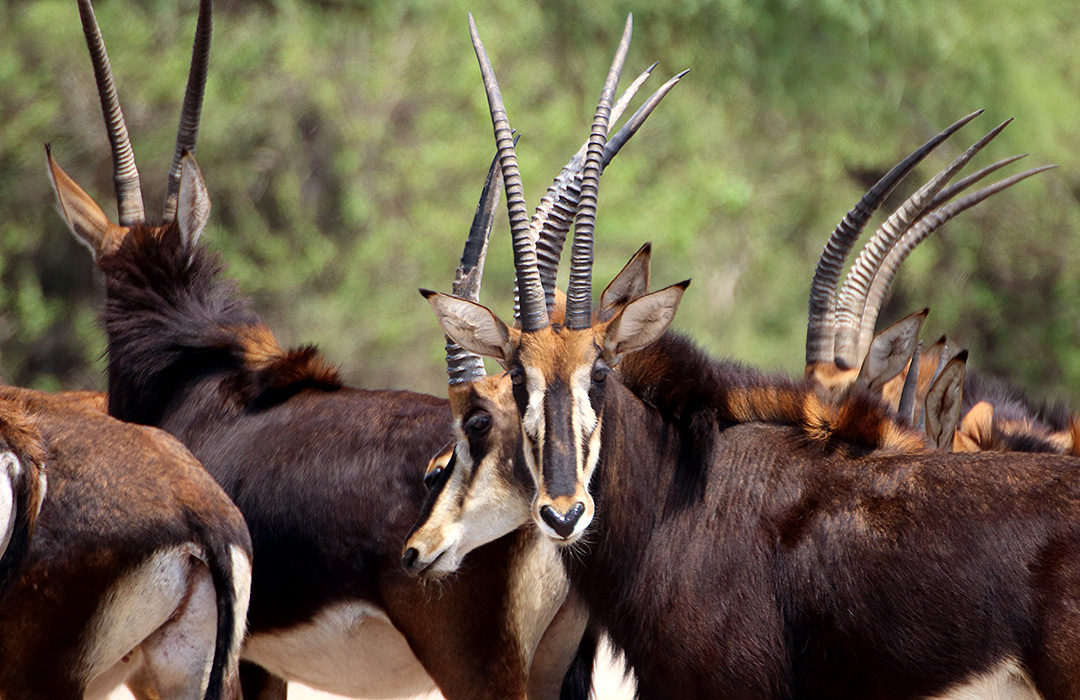

Sable Antelope
Average length of horns: 102cm. Both sexes carry horns, but those of the bull are longer and more robust. The transversely ridged horns rise up from the skull and then sweep backwards in a pronounced curve.
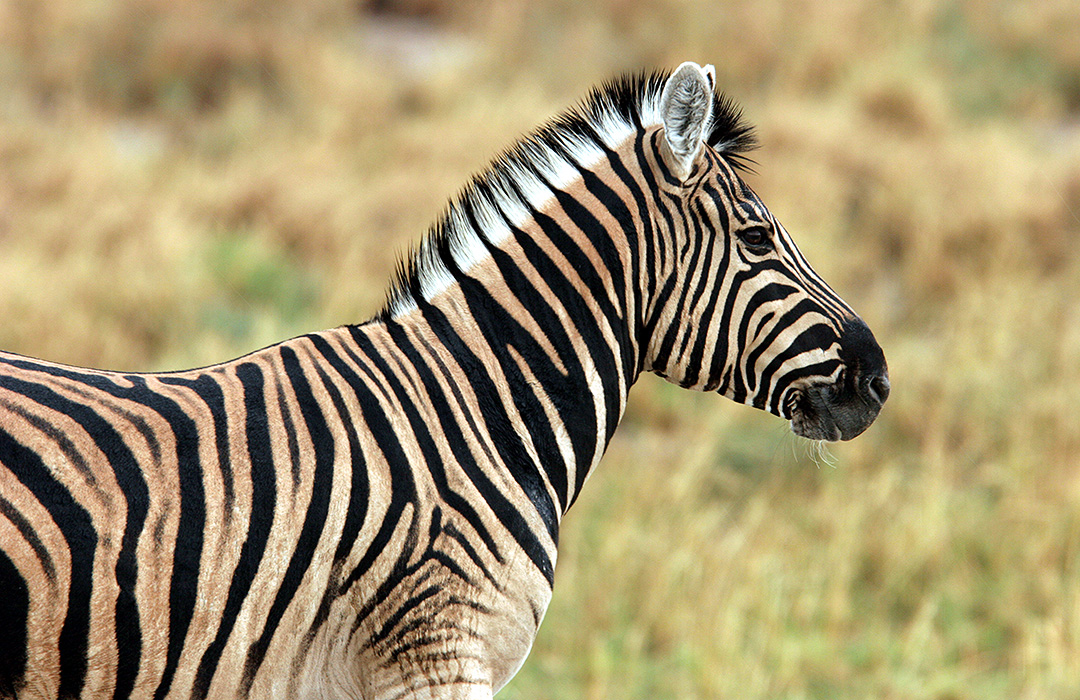
Burchell's zebra
Male and female zebras are very similar in appearance. Shoulder height is about 1.4 meters. Males usually have thicker necks than females.
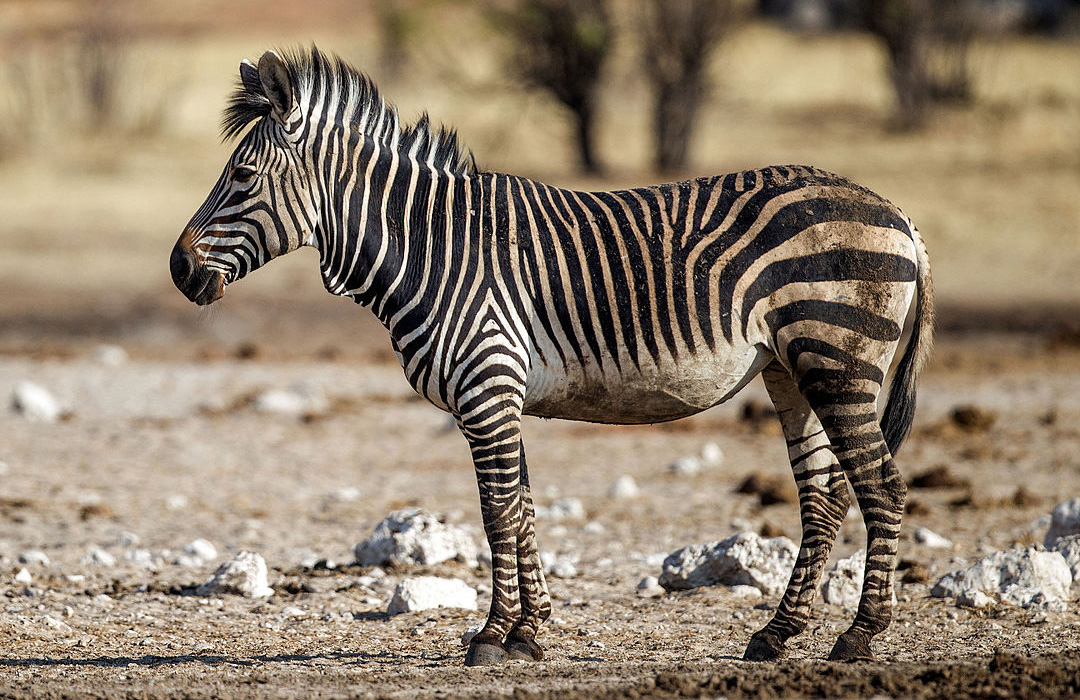
Mountain Zebra (Hartmann)
Adult mountain zebras have a head and body length of 210 to 260 cm, and a tail length of 40 to 55 cm. Shoulder height ranges from 116 to 150 cm.
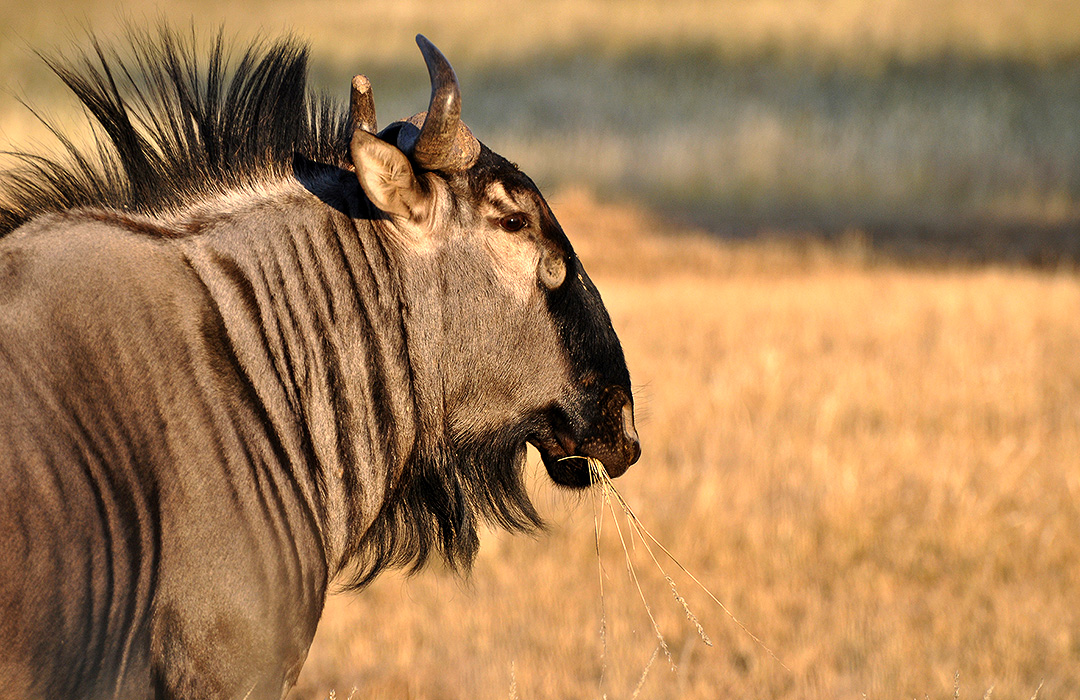
Blue Wildebeest
Blue wildebeest are large African bovids with robust muzzles and cow-like horns. The horns are long without ridges and the males’ horns are thicker with the appearance of a boss.
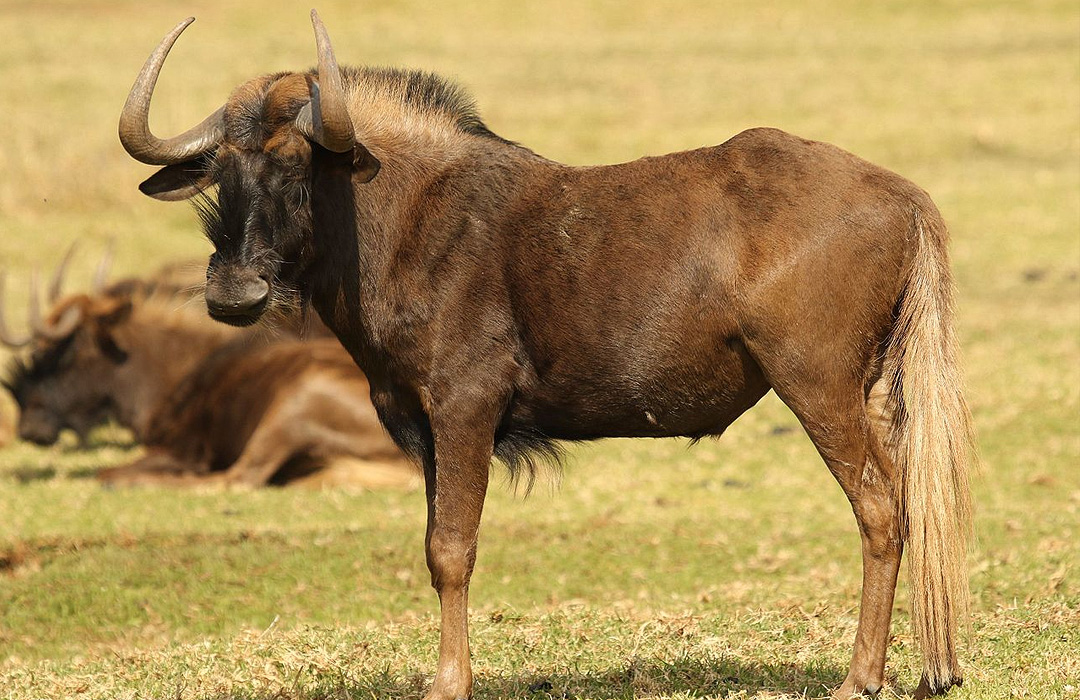
Black Wildebeest
Black wildebeest are dark brown to black in color, males being darker in color than females. Both sexes become lighter in coat color in the summer, and develop shaggier coats in the winter.
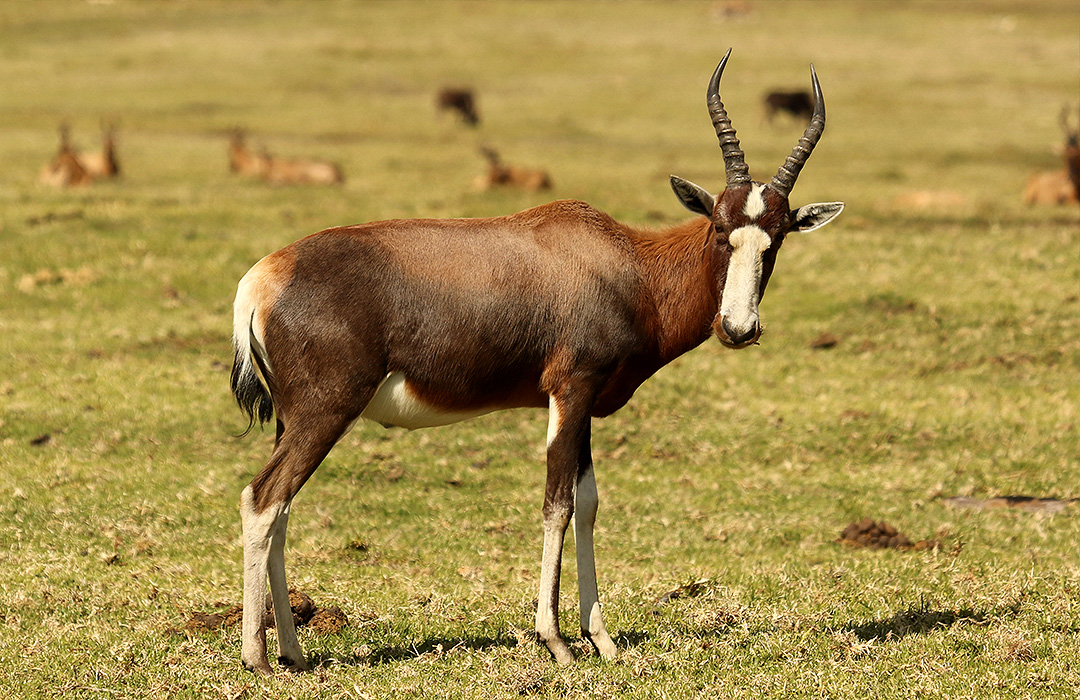
Blesbok have an adult color pattern where the relatively dark dorsal pelage contrasts sharply with high, white stockings and buttocks.
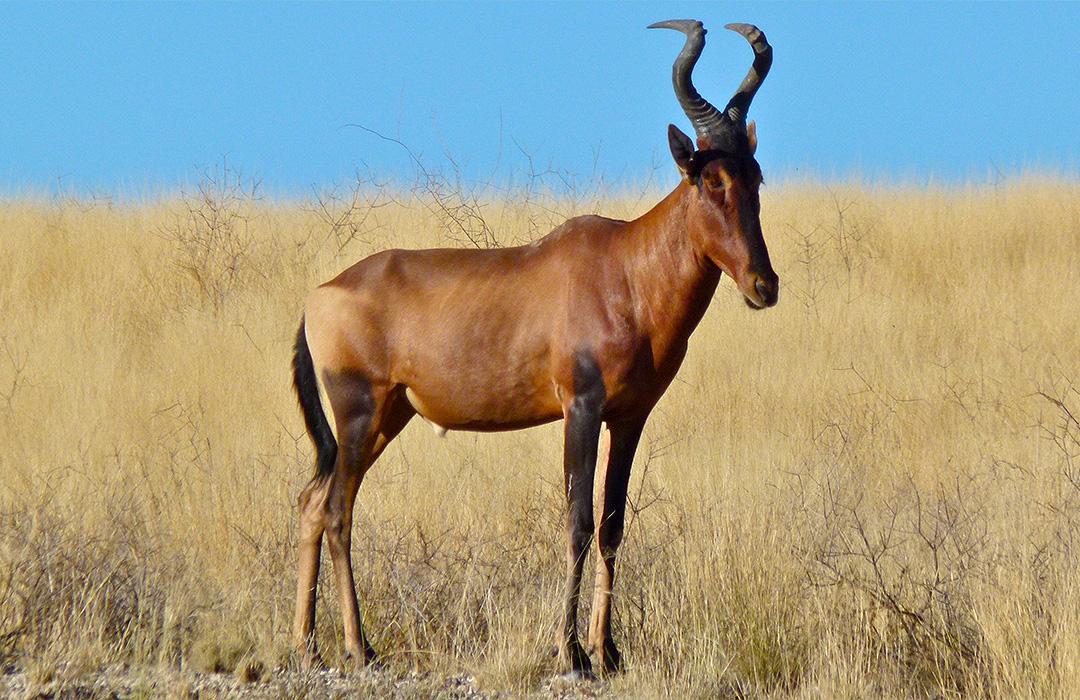
Red hartebeest
The Red hartebeest is a large ungulate ranging from 1.5 m to 2.45 m in length. Its tail is 300 to 700 mm and shoulder height is 1.1 to 1.5 m.

The steenbuck is a small antelope. The length of its head and body ranges from 70 – 95 cm. The shoulder height varies from 45 – 60 cm. The tail is very short, with total length ranging from 4 – 6 cm.
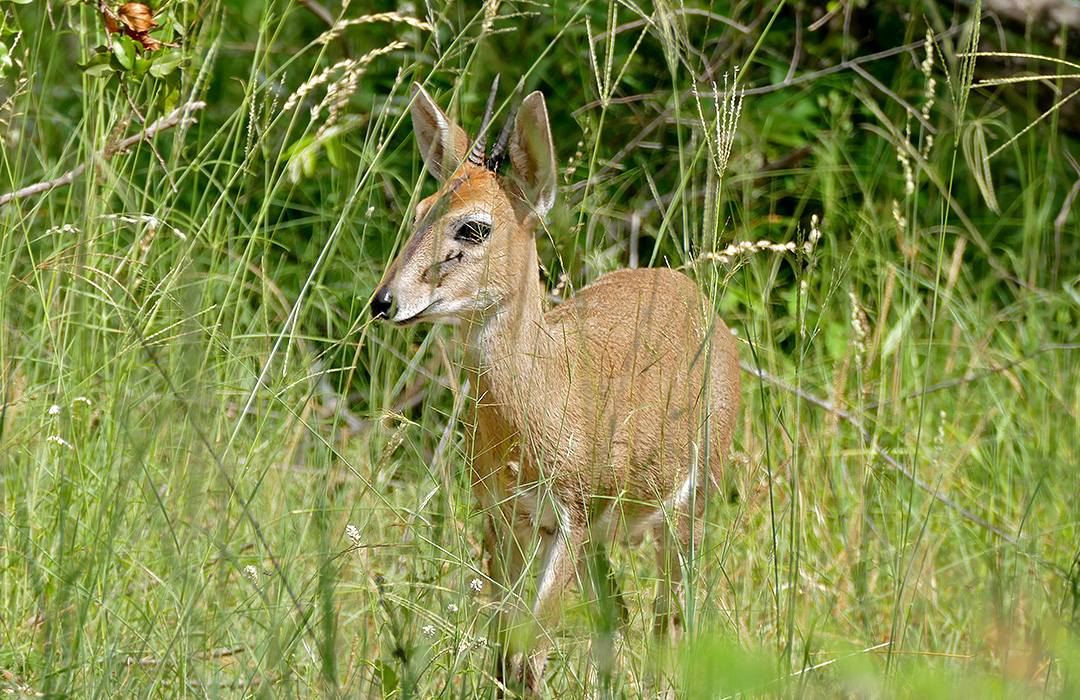
The average weights, coloration, and ear size of the gray or common duiker vary with geographic location. Females generally weigh 2-4 kg more than males in a given region.
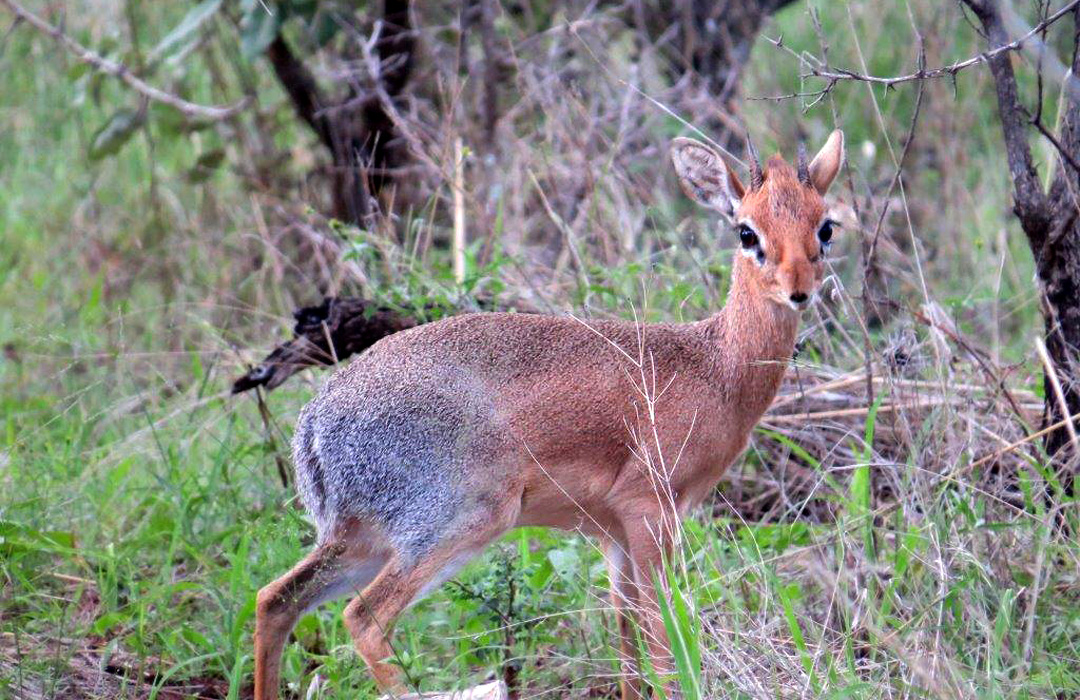
Damara dik-dik
Very small in size. Have an elongated & very mobile nose. The upper body parts are yellowish-grey with a grizzled appearance; the neck is paler than the shoulders and flanks.
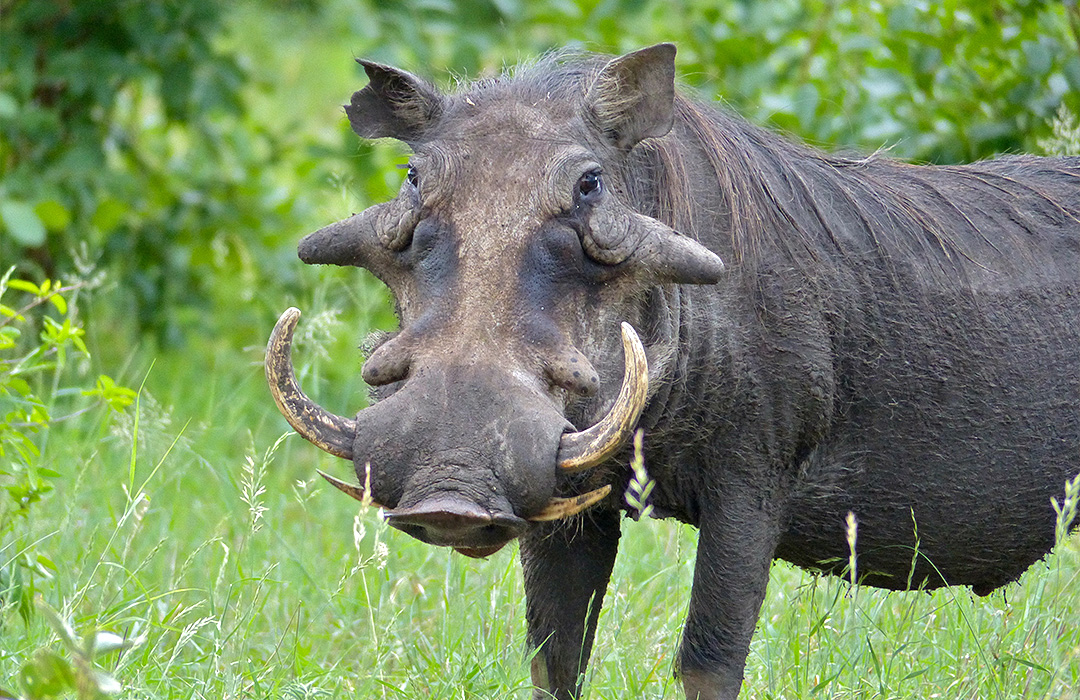
Common warthogs weigh 50 to 150 kg with females being 15 to 20 percent lighter than males. Head and body length is 900 to 1500 mm. Shoulder height ranges from 635 to 850 mm.
This website uses cookies to ensure you get the best experience on our website. Learn more
- Australian Dollars
- British Pounds
- Canadian Dollars
- New Zealand Dollars
- South African Rands
- Swiss Francs
- U.S. Dollars
Talk to an expert +44 203 405 6666 Lines open now
Duiker Safari
Duiker Safari: Day-by-day
More detailed information of what each day entails, and the various places you’ll stay on the Duiker Safari. Everything we do is completely tailor-made so while this is an idea which works well, we’ll always design an itinerary just for you.
Starts: Lusaka International Airport
Lusaka to south luangwa by flight & 4wd.
From Lusaka Airport, it’s a 70-minute flight to Mfuwe in the Luangwa Valley, where you’ll meet your guide for the 4WD journey to Kakuli. Having passed small farms and shops, you'll cross the river into the national park then game drive to the small camp, arriving after about two hours.
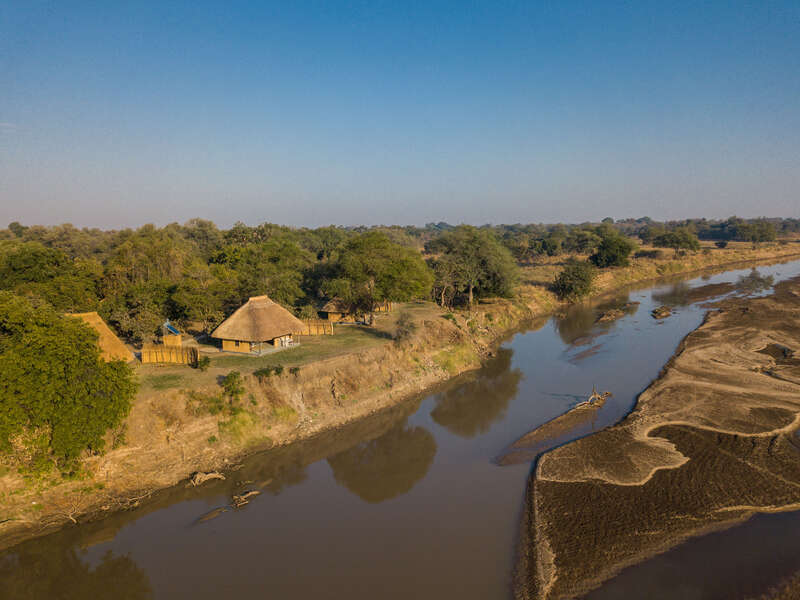
Kakuli Bushcamp
Kakuli Bush Camp is a small, intimate camp situated in an area of South Luangwa National Park known for its high density of wildlife. One of Norman Carr Safaris’ seasonal camps, it overlooks a floodplain from an elevated bank of the Luangwa River, not far from its confluence with the Lubi (pronounced Luwi) River.

"The highest points of our stay" Mr RVM from Sintra Arrived 11 Sep 2019, 3 nights
Kakuli Bush Camp is a comfortable, ‘no frills’ bushcamp in a game-rich part of the South Luangwa National Park. It’s probably best visited towards the end of a camp-to-camp walking safari, or perhaps for its walking and river trips between January to March, when very few other real bushcamps are open in the Luangwa. Note that during the hotter times of the year its open aspect and air-cooled tents provide few escapes from the heat. See our full report on Kakuli Bushcamp
Birdwatching
Cultural excursion
Guided walking safari
Night drive
4WD or walk from Kakuli to Mchenja
It's only about 7km, as the fish eagle flies, between Kakuli and Mchenja. While you can easily be driven this short distance, we'd recommend that you cover it as part of a walking safari. If you like, the route can shadow the river, which makes for a very scenic journey.
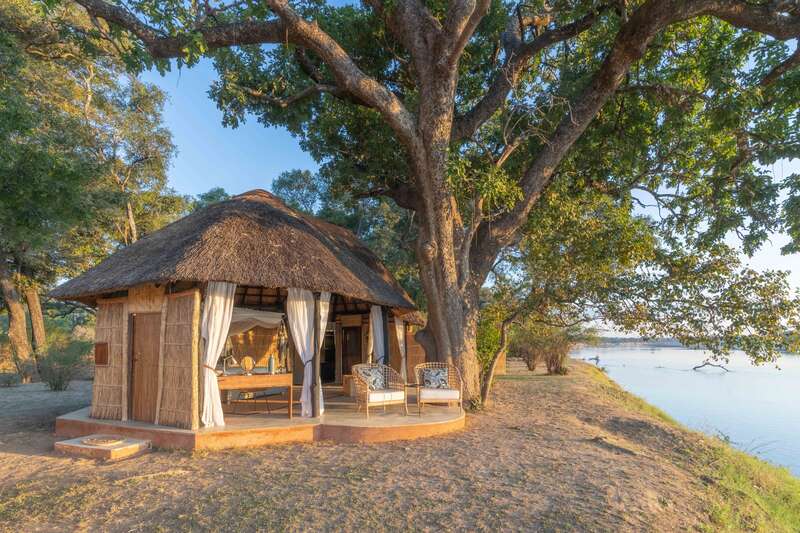
Mchenja Bushcamp
Mchenja Bushcamp is a beautiful and luxurious camp in a lovely setting within an ebony grove, beside a bend of Zambia’s Luangwa River. The whole camp has wide views of the river, and is cool and shaded under the grove of tall ebony and sausage trees around it.

"game sightings were spectacular" Mr G. from Devizes Arrived 14 Sep 2022, 3 nights
Mchenja Bushcamp is small, and rather more luxurious than most of the Luangwa's other bushcamps, so makes a fantastic and relaxing end-point for a safari in South Luangwa. We really liked the atmosphere here – it is smart but relaxed and unpretentious, which is a difficult balance to get right. See our full report on Mchenja Bushcamp
Fly-camping
Luangwa to Lower Zambezi by air & 4WD
After driving from Mchenja to Mfuwe Airport, you’ll pick up a light aircraft for Royal Airstrip, flying over the Luangwa and Zambezi escarpments. A guide from Chongwe will meet you for the game drive to camp, though you may complete the 3–4 hour journey by boat along the Zambezi.
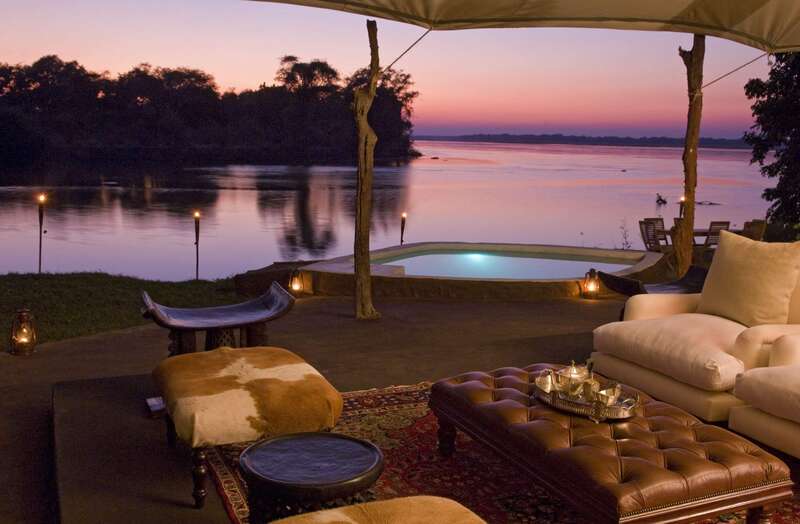
Chongwe River Camp
Chongwe River Camp is located at the confluence of the Zambezi River and its tributary, the Chongwe River, which forms the western boundary of the Lower Zambezi National Park. It lies in a game management area (GMA) that reaches a further 80km west along the Zambezi – so while it is outside the (unfenced) park boundary, it is still in a very productive wildlife area, with elephants regularly seen in camp.

"We spent a day fishing - that was a good break from the jeep." Mr P & D from Australia Arrived 19 Jul 2022, 5 nights
Chongwe is a great camp with a stunning location and it is very good value – especially when compared with camps within the Lower Zambezi National Park itself. Due to its location it can take a bit longer to get to the best wildlife areas in the park, but this doesn’t detract greatly from your game viewing experience, partly due to the excellent guiding you’ll find here, but also due to the plentiful wildlife around the camp itself. See our full report on Chongwe River Camp
Lower Zambezi to Lusaka by 4WD & light aircraft
Flight times depending, you'll usually have time for a game activity and a quick brunch at Chongwe before heading on a last hour's game drive to Royal Airstrip. From there you'll fly up and out of the low-lying Zambezi Valley, arriving at Lusaka Airport about 40 minutes later.
Ends: Lusaka International Airport

Need inspiration?
Let our trip chooser narrow down the options for you
Side-trips whilst on this safari
We may be able to build some of these optional excursions into your Duiker Safari. Talk to us: they’re usually best arranged when you book.
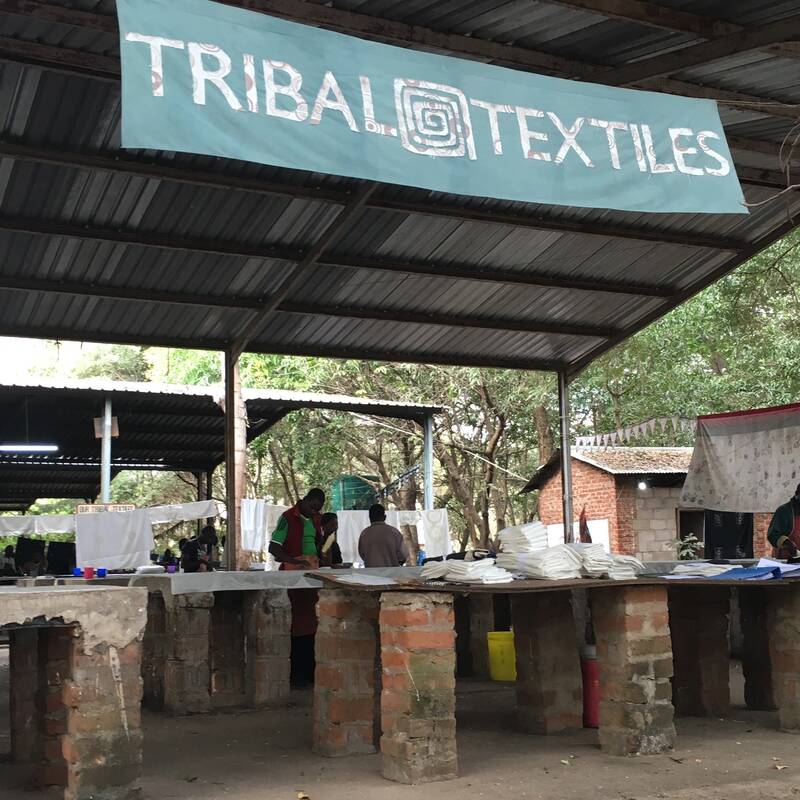
Tribal Textiles Tour
One - two hours
Visit the Tribal Textiles workshop , where hand-painted textiles are produced by more than a hundred local people. The workshop is close to Mfuwe Airport, so is ideally placed for a stop en route to/from the South Luangwa. With products ranging from cushion covers to bags and T-shirts, it's a great place for souvenir shopping while at the same time supporting the local community.
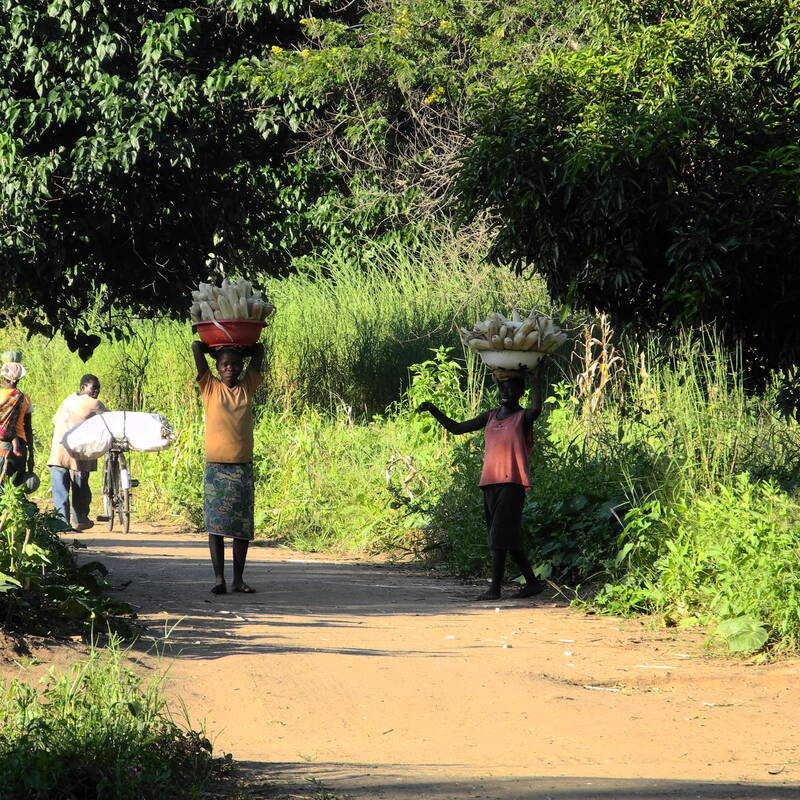
Kawaza Village Visit
Two to three hours
Just outside Zambia's South Luangwa National Park lies a normal, working rural African village which is open and welcoming to visitors to the Luangwa valley. There is nothing artificial or contrived about Kawaza Village , and it offers a rare opportunity to experience and appreciate Kunda culture, and meet local Zambians.
Login to Expert Africa
Sign in with password
Sign in with email link
New to Expert Africa? Create an account
Forgotten your details?
It's free & quick to set up
- Save your wish-list
- Send us an enquiry
- Pay online for your trip
- Subscribe to our newsletter
- Give us feedback on your trip
- Full site benefits of the site
Need some help? Talk to our team
Hunting Safaris
- photo gallery
Namibia, is the hunting world's best kept secret, where all you have ever dreamt about hunting in Africa is a reality. The experience to feel the fresh and clean air on your face at the crack of dawn, and the sound of the morning wild gives you the freedom and feeling of dark Africa.
Onduri Hunting Safaris lodge is located 450 km NW of Windhoek on a 13,000 ha farm, near Outjo and the Etosha National Park. Due to its location and hilly landscape, we offer kudu, springbuck, blue and black wildebeest, warthog, hartebeest, duiker, Impala and steenbuck as well as cheetah and leopard hunts. Other predators like Hyena ext can also be shot in luck. We also hunt the 450,000 ha Etosha Conservancy, which we are part off.
Come and hunt with us, and you will return time after time....
Onduri Hunting Safaris, the best hunting in Namibia.
email: [email protected]
Postal address: Onduri P.O.Box 270 Outjo Namibia
Contact numbers: tel: +264 67 312 125 fax: +264 67 312 114 cell/mobile: +264 81 127 2137
Duiker Safaris Namibia
We make your african dream come true.

Duiker Safaris
Details.....
Farm Duiker 929 Grootfontein Namibia
Hunting area:
Our hunting area has an area of around 40,000 ha.
All Plains game species
Special:
Accommodation:.
Hunting Camp
Activities:
Visits of Etosha National Park and in a Bushmen village
Duiker Safaris P.O. Box 252 Grootfontein Bennie Boshoff +264 81 255 7161 [email protected] https://www.duikersafari.com/
some Photos

visit our WEB Site
© Copyright 2023 Hunting Portal Namibia - All Rights Reserved

Duiker: one of the most diverse African animals
In Africa, there are small antelopes that dash around swiftly and leap quite high. Due to their diminutive stature, they constantly play hide-and-seek within thickets. It is a necessity to evade the multitude of predators eager to claim them as prey. At the slightest hint of danger, those antelopes dive into the nearest bushes.
This article will tell you all about them. You will learn:
- What are the different duiker species?
- Their hiding spots and the reason for being called "divers."
- Unveiling their eating habits - are they strictly herbivores?
- Understanding the purpose of the black stripes beneath their eyes.
- Tips for raising a young duiker, even for beginners.
- Suggestions on where to spot these charming antelopes in the wild.
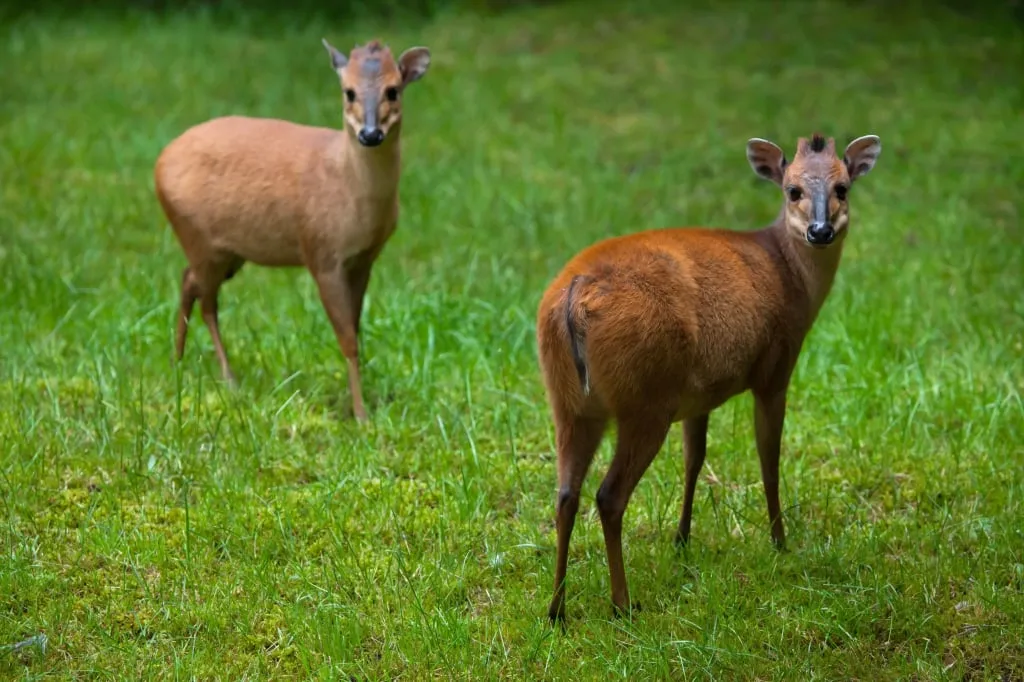
Why are they called "duikers"?
If you know Dutch or Afrikaans, you'll recognize a connection to diving in the word "duiker." Essentially, the Dutch word "duiker" translates to "diver, underwater swimmer, scuba diver" in English. In Afrikaans, which evolved from Dutch dialects during the colonial era, the term stuck. Thus, the link between the language of Northern European residents and the small antelope in Africa is explained.
As mentioned earlier, the shy antelope swiftly leaps and hides at the slightest danger in the nearest thicket, almost diving into it. This behavior was observed by early explorers of African fauna. So it became the name for the entire subfamily of horned animals.
In some languages, duikers are also referred to as "crested antelopes." Most species sport a comical crest of hair on the crown of their heads—a bunch of standing-up hairs.
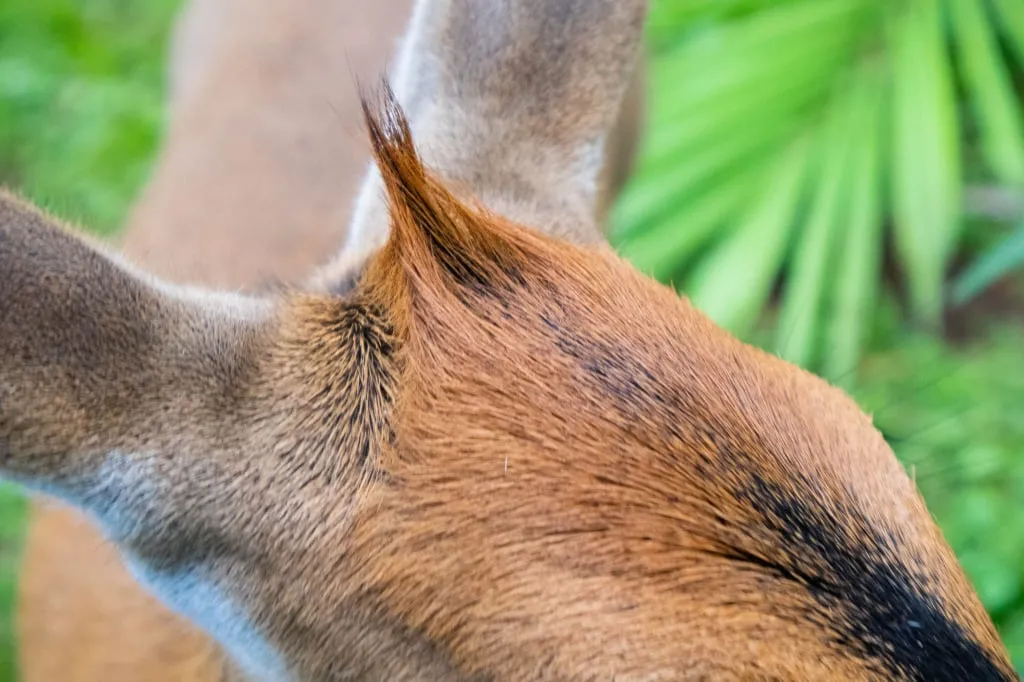
Scientifically, the duiker belongs to the subfamily Cephalophinae . Sometimes they are grouped as Cephalophini in certain classifications. In both cases, the names trace back to "Cephalo-" meaning "head." Today, the classification of duikers is intricate and convoluted. So many original meanings embedded in their names are lost.
What duiker species are there?
Given the somewhat conditional definition of "antelope," learning about the confusion in the genera and species of duikers is not surprising. Different systems list varying numbers of duiker species, ranging from less than 20 to over 40. Classifications are dynamic, with some representatives shifting to adjacent genera, and others forming entirely new ones. In addition, as is common in modern zoology, some subspecies become independent species.
Now let's take a look at representatives of some duiker species. We'll admire their distinctive features, and learn the most interesting facts about them. Let's start with the smallest ones — blue duikers.
The blue duiker
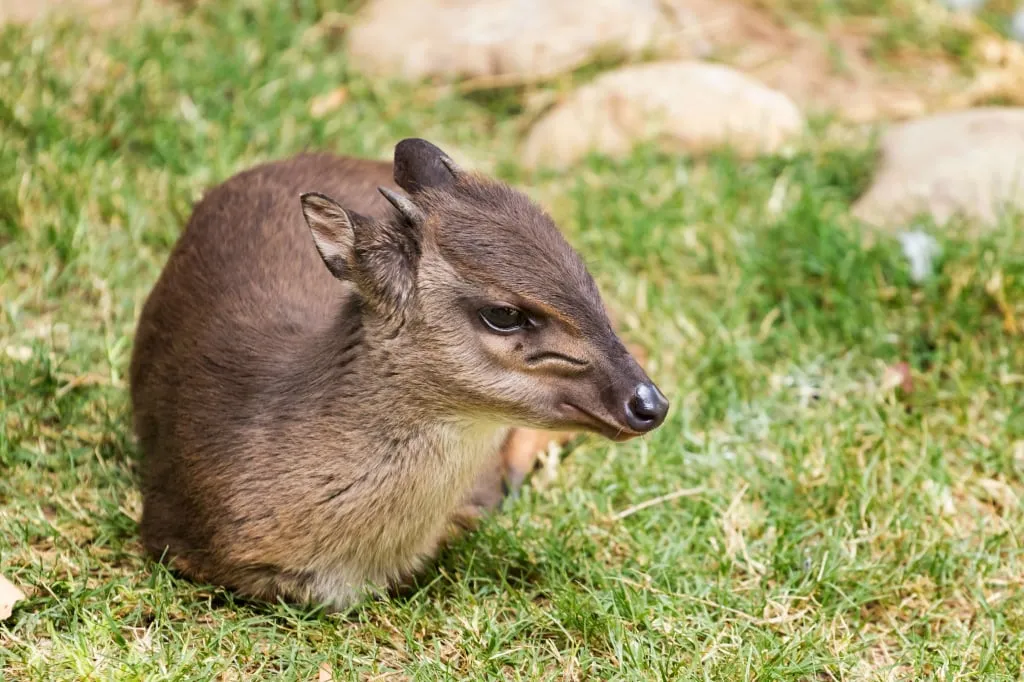
Common Name: Blue Duiker
Scientific Name: Philantomba monticola
Lifespan: 10–12 years
Size: 32–41 cm (12.6–16.1 in)
Mass: 3.5–9 kg (7.7–19.8 lbs)
Conservation Status: LC, Least Concern
Demographic Trend: Decreasing population
In the forest, if you remain quiet and inconspicuous, you might spot these small antelopes nimbly darting from one fallen tree trunk to another. In clearings, they graze on fallen leaves, fruits, flowers, and bits of bark. However, a snap of a twig, and the antelope, crouching and leaping, vanishes instantly
These elusive creatures measure only 60–90 cm (23.6–35.4 in) from their short, agile tails to the tip of their noses. Their shoulder height never exceeds 40 cm (15.7 in). Often blue duikers are only around 30 cm (11.8 in) tall. They have small heads with short ears, large black eyes, and black stripes running from the eyes to the nose. These are scent glands producing aromatic substances. Duikers rub their faces on branches, leaves, and logs. This leaves behind an individual scent that signals to kin that they've entered a foreign territory.
The blue duikers' name is due to their coat looking grayish-brown with bluish tint in the forest shade. There are over a dozen subspecies of the blue duiker. They vary in coat color, generally ranging from gray to dark brown. Some can even have shades approaching entirely black.
If you think these typically 4–6 kg (8.8–13.2 lbs) creatures are entirely harmless, take note of their short horns. Both males and many female blue duikers have sharp horns measuring up to 5 centimeters (2 inches). In conflicts with other duikers or smaller predators, this antelope might use its horns to jab. If they add the strength of their hind legs behind the jab, it will certainly hurt!

Diet of blue duikers
How do these animals find sustenance? During the day, they explore their territory, discovering not only flowers, leaves, and seeds but also mushrooms. Another way to find their favorite treats is by following the sounds of loud birds or noisy monkeys feeding high in the trees. The ground around them is sure to be scattered with fallen fruits, flowers, and fresh leaves. In this regard, the best allies of blue duikers are Cape parrots, baboons, and white-throated monkeys. The reason is that they all share a similar diet.
Habitat and lifespan of blue duikers
Where and how long do blue duikers live? In the wild, these antelopes typically live for 10–12 years. They are exclusively forest antelopes, which is reflected in their scientific name— Philantomba monticola . The second word here refers to the Latin montis, meaning "mountain." They inhabit forests of various types, including rain forests, with sightings recorded at altitudes up to 3000 meters above sea level.
Their range primarily spans central and western parts of sub-Saharan Africa. Extensive habitats of these forest duikers also exist in eastern and southern Africa. Surprisingly, the smallest duikers are widely distributed and claim the largest territories. In contrast, many larger duikers survive on a small territory and are classified as endangered due to habitat loss and other factors. According to the International Union for Conservation of Nature (IUCN), blue duikers face no significant threats. Generally, one of the most severe threats to duikers is human activity, including hunting. However, these antelopes are so small and swift that they are rarely hunted.
Researchers have observed another intriguing interaction between blue duikers and humans. These antelopes often come quite close to human dwellings. Due to their small size, they sometimes create nighttime resting places in woodpiles. However, when humans dismantle the woodpile, the animal loses its accustomed nighttime haven.
The natural enemies of the blue duiker include leopards, African golden cats, civets, hyenas, African wild dogs, monitor lizards, crocodiles, baboons, crowned eagles, and pythons. This list is not exhaustive, so the skittishness among the main traits of duikers is not without reason. They can hardly afford to roam freely as some of the larger herbivores.
Red-flanked duiker
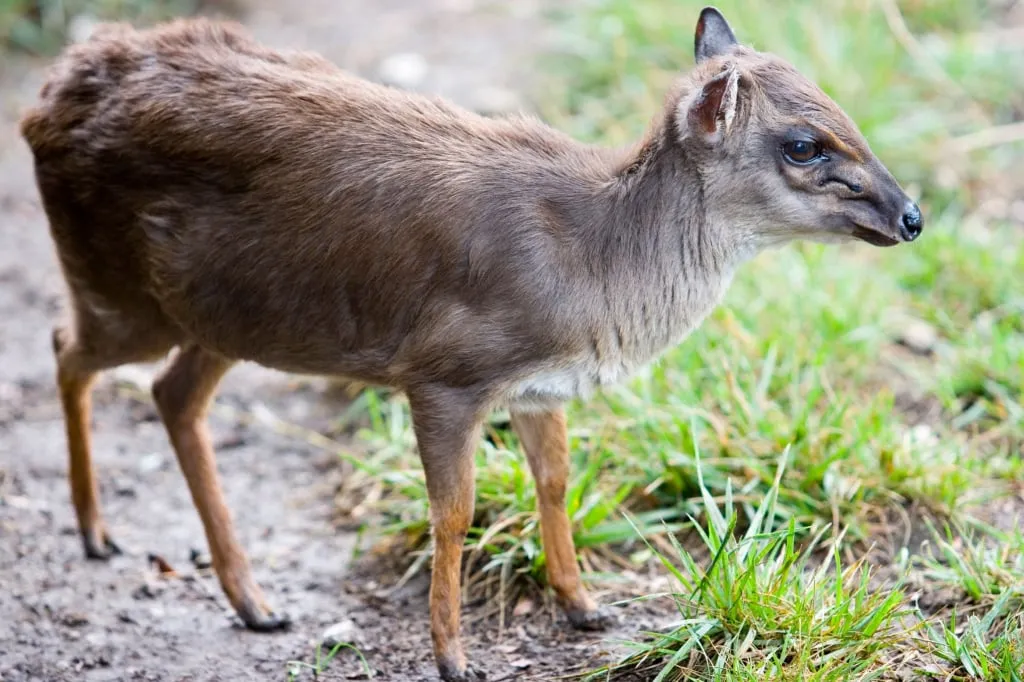
The red-flanked duiker, among the smallest duikers at an average height of 35 cm (13.8 in), closely resembles the blue duiker. Adult antelopes weigh between 12 and 14 kg (26.5-30.9 lbs). True to its name, the red-flanked duiker has orange-red fur, featuring a grey-black stripe from its head to the tail. The stripe extends over the muzzle, reaching the shiny black nose. The leg shins are also black, resembling the animal wearing socks. This characteristic is shared by many duiker species.
Male duikers grow horns up to a maximum of 9.5 cm (3.7 in). Horns in females, if present, are half that length. Similar to all Cephalophus species, these Cephalophus rufilatus duikers possess eye-pouch protuberances. These pouches, marked with black stripes, contain a preorbital gland secreting fluid for territory marking. Among all duiker species, the red-flanked duiker has the largest of these glands.
A distinctive trait of this species is its non-participation in social grooming. Although grooming is typical behavior in the Cephalophus genus , red-flanked duikers abstain from it.
Diet of red-flanked duiker
Their diet is akin to that of other duikers, consisting of leaves, fruits, flowers, shoots, and branches. Typically, they feed within a one-meter distance from the ground. Some duiker species reach higher areas by standing on their hind legs and leaning on tree trunks. These antelopes play a significant role in seed dispersal. They consume fruits like figs, wild plums, peaches, dates, and other fruit trees, spreading seeds via their digestive systems.
Habitats and lifespan of red-flanked duiker
Red-flanked duikers inhabit Central and West Africa. Their lifespan is around 5 years on average, although some may live up to 10 years. Predators such as leopards, eagles, and pythons pose threats, but humans remain the most perilous. Hunting for meat significantly impacts their population. Humans use nets and loud noises to trap the skittish animals. Despite population decline, their conservation status in the wild is considered of Least Concern. This is due to their ability to adapt to changing conditions and colonize new forest areas away from human deforestation zones.
Zanzibar Duiker
The Aders's duiker, is a unique African antelope that underwent taxonomic reevaluation in 2022. It was moved from the Cephalophus genus to a new, unique genus named Leucocephalophus . So it was renamed Leucocephalophus adersi . The prefix "leuco-" meaning "white" refers to the distinctive white stripe beneath the duiker's reddish-brown flanks, extending to its hind legs.
The common name and the second part of the scientific name honor W. Mansfield Aders. He was a biologist from Zanzibar who first provided a specimen of this new species for description. Found on the Zanzibar archipelago and two forested areas slightly north on the ocean coast of Kenya, it's semi-endemic to Zanzibar. Zanzibar is a group of islands in the Indian Ocean off the coast of East Africa, part of Tanzania.
Initially, this species was considered endangered. However, a new population was discovered in Kenya, leading to a conservation program for these animals. In the late 20th century, scientists counted only about 600 individuals. Today, the population is estimated at 14,000. Despite this increase, the Aders's duiker's status remains Vulnerable. As part of the conservation program, some antelopes from larger islands like Unguja and Pemba were relocated to smaller ones, such as Chumbe, Tumbatu, and Mnemba. Observers noted that this population was able to grow over time.
As part of the same program, the local blue duiker population is also being restored. We are talking about the population exclusive to the islands of Pemba, Unguja, and Mafia — the largest islands of Zanzibar
So what connects the Ader's duiker with representatives of other forest duikers? They inhabit mangrove thickets on the coast, have a red tuft of hair on their heads, and horns up to 6 cm (2.3 in) long. They lead a diurnal lifestyle, living alone or in groups of 2–3 individuals. Considered herbivores, they particularly enjoy berries and flowers. Forest duikers often supplement their diet with shoots, stems, and leaves. Monkeys, including Zanzibar red colobus and white-throated monkeys, help them find berries by feeding high in the trees and dropping fruits to the ground.
Data on sizes vary significantly. Most reports mention them as relatively small antelopes, within 32 cm (12.6 in) at the withers. Although there is information about individuals reaching 44 cm (17.3 in). The average weight of the Aders's duiker is 9 kg (19.8 lbs), with a maximum of 12 kg (26.4 lbs).
As we can see, apart from specific habitats and the distinctive feature of white fur, the Ader's duiker is a typical representative of this group of antelopes.
Zebra duiker
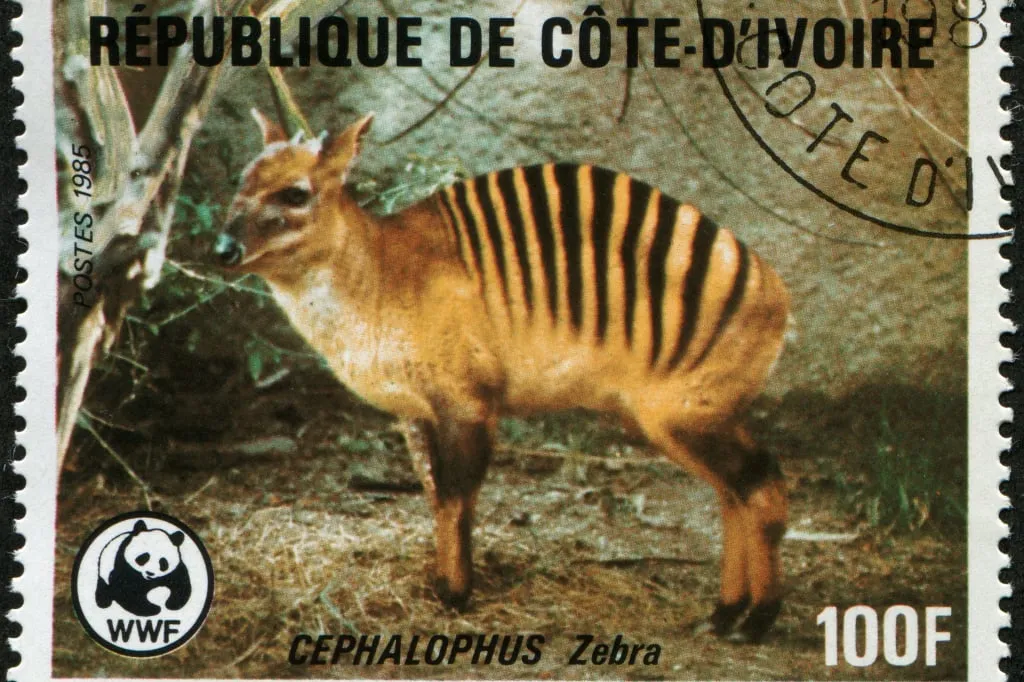
This is one of the most interesting duikers, distinctly different in appearance from all other species. On its light-orange back, it has many black stripes. This is why it is called so in all languages and even in the scientific community - Cephalophula zebra . It has 12 to 16 stripes.
This generic classification is controversial because most scientists traditionally classify this duiker under Cephalophus . The story here is the same as with the Aders's duiker. Due to significant differences, the zebra duiker was placed in a separate genus.
The average height of the zebra duiker at the withers is 45 cm (17.7 in), although some individuals can grow up to 50 cm (19.7 in). These animals weigh up to 20 kg (44 lbs). Like most duikers, females are usually larger than males. Same as with other duikers, not only the males can have horns. However, in males they are longer than in females, reaching a length of 5 cm (2 in).
These duikers can only be found in a small area - in a specific region of West Africa. They live in the lowland forests of Liberia, Guinea, Ivory Coast, and Sierra Leone.
Zebra duikers are herbivores - they feed on fruits, leaves, and shoots. Like other crested antelopes, zebra duikers follow monkeys, birds, and bats accidentally dropping fruits to the ground. Also, an interesting behavior has been observed in them. Thanks to the thickening of the frontal bone, zebra duikers can break the hard shells of fruits.
Unfortunately, the fragmented population of zebra duikers is decreasing. Fewer than 10,000 individuals remain today, and the species status is Vulnerable. It is even more painful to read the joyful reports of hunters proud of their killing of beautiful zebra duikers. Human activity poses the greatest threat to the species: hunting and deforestation.
Their main body color is reddish-brown, hence the name. There is a noticeable black stripe running along the entire back, from the tail to the head, wider in males
These duikers grow up to 45-50 cm (17.7-19.7 in) in height, measured at the shoulders. They are larger than the zebra duikers and can reach a weight of 23 kg (50.7 lbs). Females, as usual, are slightly larger than males. Both sexes have horns but in males they are longer, reaching a maximum of 8 cm (3.1 in). The longest horns ever recorded reached a length of 12 cm (4.7 in). The ends of the duiker's horns are quite sharp.
Bay duikers live only in West Africa, in lowland tropical forests near the ocean coast. However, there is information that they also inhabit Central African countries. The reports say they inhabit fairly extensive areas, reaching the Great African Lakes. However, they refer to the Cephalophus castaneus , which was previously considered a subspecies of our Bay Duiker ( Cephalophus dorsalis ). Their ranges are separated by a very wide strip on the map. So, in new classifications, they are considered different species
The bay duiker is a nocturnal animal, preferring to rest in secluded places with dense vegetation during daylight hours. Like other antelopes, they eat fruit, preferring mango and jackfruit. The diet is supplemented with leaves, grass, buds, and shoots. However, it is known that bay duikers can also eat bird eggs, insects like termites and beetles, and even carrion, such as dead mongoose pups and hedgehogs. Moreover, cases of intentional hunting of small birds have been recorded. Interestingly, the antelope does not eat the wings and legs.
And who hunts these duikers? Of course, leopards, as well as eagles, owls, pythons, monitor lizards, and crocodiles. But again, the greatest threat comes from humans. Poaching and habitat destruction are the main threats to this species, which is close to a vulnerable position. It's crucial to address these threats to ensure the survival of these magnificent creatures in their natural habitats.
Bush duiker

If we move from small duikers to larger ones, the next one worth taking a closer look at is the bush duiker ( Sylvicapra grimmia ). Many representatives of related species closely resemble each other, differing only in details of appearance and range. So, we wouldn't talk about each one here. For example, the blue duiker closely resembles Maxwell's duiker and Walter's duiker. In fact, these three all belong to the same genus. But our next duiker looks like no other.
The bush duiker earned its name for a reason. It is the only duiker that chooses open savannah spaces for living. It is content with bushes and tall grassy thickets to remain unnoticed. All other duikers are strictly forest dwellers preferring more dense cover. Another external difference of the bush duiker from all others is that, in a calm state, it holds its back straight. Whereas in other duikers, it is constantly arched.
The common duiker and the bush duiker are two names for the same duiker species. This is a very common antelope that can be found almost throughout Africa south of the Sahara.
Bush duikers live in open meadows and savannahs with low trees and bushes. They can also be found in hilly terrain and mountains where there are no dense forests. Interestingly, among all the hoofed creatures in Africa, bush duikers are known for inhabiting some of the highest altitudes. They have been spotted high in the mountains, where other antelopes do not venture.

Bush duikers, on average, grow up to 50-60 cm (19.7-23.6 in). They weigh from 12 to 25 kilograms (26.4-55.1 lbs). Judging by their weight, these animals are already of predatory interest to humans. In addition to meat and skin, in Africa, the horns of these antelopes are used. People make decorations from them. In the past, pendants made from the horns of these animals were used as talismans.
All male bush duikers have horns. In females, this is a variable phenomenon, depending on the habitat. At the same time, the horns in females are shorter. The longest recorded horns of a common duiker reached 18 cm (7 in). On average, they are usually about 11 cm (4.3 in) long. There were findings of dead rock pythons whose stomachs were pierced by the sharp horns of common duikers they swallowed whole.
The bush duiker has many subspecies, so the fur color varies from light gray to dark gray, often with shades of brown. Interestingly, the color depends on the conditions in their habitats. In arid places, light gray shades prevail, and in wet ones, dark gray. There is also a quite logical pattern - the higher the duiker's habitat in the mountains, the longer its fur.
Bush duikers are predominantly nocturnal inhabitants, active during the dark hours, early in the morning, or late in the evening. During the day, they prefer to rest in safe lairs.
These duikers are considered omnivores. In addition to leaves and shoots, flowers, and fruits, they eat insects and other prey. For example, ants, caterpillars, as well as lizards, various rodents, and even birds. We know that blue duikers sometimes accidentally eat insects and bird eggs. However, bush duikers deliberately hunt for small animals, not hesitating even to scavenge.
What's also interesting is that bush duikers actively use their hooves to dig out tubers and roots from the ground, which they also like to feast on. People do not like them for this and consider them pests. Penetrating into agricultural land, duikers dig up potatoes, peanuts, and other crops.
Who else, besides humans, can threaten bush duikers? These include eagles, leopards, cheetahs, lions, jackals, crocodiles, and the mentioned pythons. If a duiker manages to hide from threats and quickly dive into the bushes in time, it can live up to 8-11 years. That is the natural lifespan of a bush duiker in the wild.
In captivity or an artificially safe environment, like other animals, common duikers live longer, reaching up to 14 years. We at Altezza rescued an orphaned baby bush duiker. We raised and released it into partially wild spaces. We hope that she will live a long and fulfilling life.
In 2022, quite unexpectedly for us, a little antelope, still a baby, came under our care. The locals brought her to the Altezza Travel office at the Aishi Machame Hotel . We had to study a lot about the needs of bush duikers to avoid harm and prepare her for independent living. It took several months.
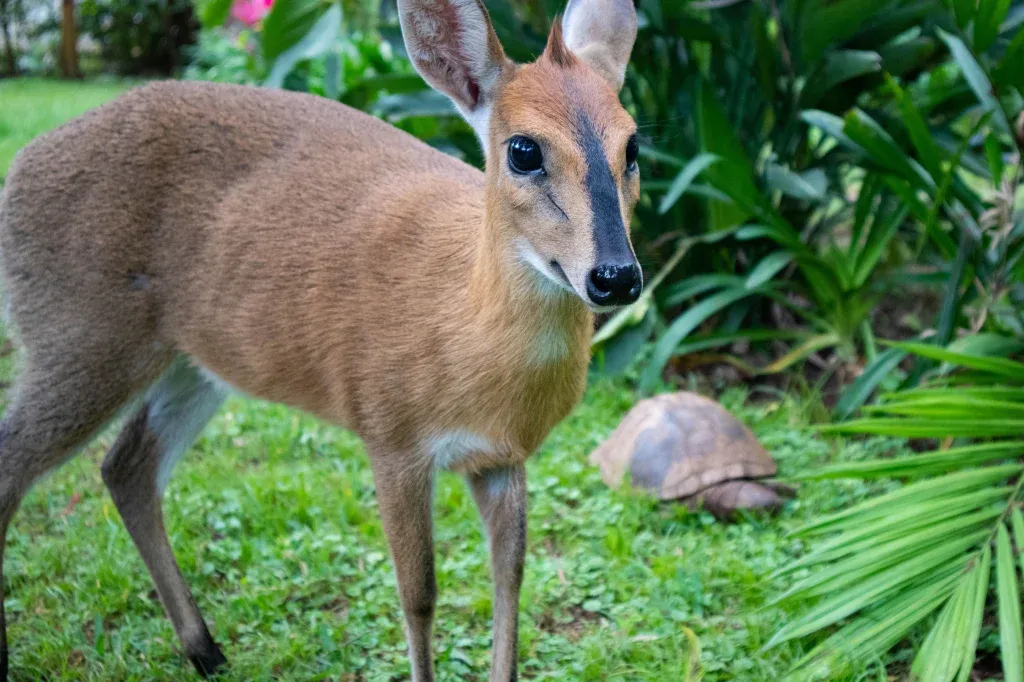
Read the full story of our little Nyasi, the bush duiker from Tanzania, in our blog. There are many photos and fascinating details about the growing up of the common duiker.
The Tanzanian duiker (Abbott's duiker)
Moving on, it's time to take a brief look at the duiker which in some languages such as Bulgarian and Russian is commonly referred to as the Tanzanian duiker. This is justified by the fact that the animal is an endemic species of Tanzania. It inhabits only a few scattered mountainous zones in the country.
The scientific name of this duiker is Cephalophus spadix . In English and German-speaking environments, the name Abbott's duiker is more prevalent. It honors the remarkable American naturalist William Louis Abbott. In the 1880s, he traveled through what was then Tanganyika The mainland part of Tanzania was called Tanganyika until 1964, named after the expansive lake that bordered the country to the west, separating it from the rest of the African mainland. and even climbed Mount Kilimanjaro. It was there that he discovered this new species of antelope.
It may seem that more than a hundred years have passed, but we still know relatively little about this duiker. For instance, its first photograph surfaced in 2003, and the results of the initial genetic studies on Tanzanian duikers emerged only in 2014. The species has been classified as endangered. Abbott's duikers are dwindling, with only about 1500 remaining. They face threats from hunting, as traps are set for them. Another significant threat is logging in their habitats.
Abbott's duikers inhabit only five locations in Tanzania: Mount Kilimanjaro, the Southern Highlands, the West Usambara Mountains, Rubeho, and the Udzungwa Mountains. The latter location harbors the largest population of this species. In all these regions, they live in high-altitude forested areas, ranging from 1300 to 2800 meters (4265 to 9186 feet) above sea level. There are reports that they occasionally ascend to 4000 meters (13123 feet). They have also been spotted in low-lying forests at an altitude of 300 meters (984 feet) above sea level.
On average, Abbot's duikers grow to about 65 centimeters (25.6 inches) at the shoulder. However, individuals as tall as 74 cm (29.1 inches) are known. They weigh approximately 55–60 kilograms (121.3–132.3 pounds). They have short brown fur ranging from walnut to dark brown shades. These antelopes are easily distinguished from all other duikers by their elongated muzzle. They have a large crest of red or even bright orange color on their heads. Descriptions of the animal are almost exclusively based on camera trap footage placed in dense mountainous forests.
Abbot's duikers are considered one of the most elusive species of duikers and certainly the rarest. Even researchers rarely encounter them in their natural environments. They lead a nocturnal lifestyle, which complicates observation.
It is known that Abbot's duikers feed not only on flowers, grasses, mosses, and fruits but also on small animals like frogs. In turn, they are hunted by leopards, pythons, crowned eagles, and in the Udzungwa Mountains, by lions and spotted hyenas. There have been reports of cases where, in self-defense, they transitioned from fleeing to aggressive defense, even killing pursuing domestic dogs. Presumably, these are small-sized dogs, as in Tanzania there are few large dogs.
Very little is known about the social life, reproduction, and other aspects of Abbott's duikers. This antelope remains a mysterious creature, generating significant interest among scientists.
In Tanzania, since 2002, a program has been in place to protect this endangered species. The habitats are studied, population numbers are counted, forest corridors are protected, allowing mountain antelopes to expand their range. Traps set by poachers are removed. Lectures and other events involving the local population are conducted to raise awareness about these animals and engage young Tanzanians in the conservation effort.
In Swahili, the official language of Tanzania, this species of antelope is called minde. Wildlife clubs for children called Minde Wildlife Clubs have been established. Conservationists in Tanzania actively involve children in educational programs because this method is the most effective. Children not only acquire information themselves but also relay it to older relatives at home.
Let's hope that the measures being taken will preserve the population of these wonderful Tanzanian duikers.
Jentink's duiker
In most Western languages, this antelope is known as the Jentink's duiker, named after the Dutch zoologist Fredericus Jentink. This name (Cephalophus jentinki) was assigned to the antelope by the prolific British zoologist Thomas Oldfield. Oldfield dedicated his life to the systematization of mammals and described over 2000 new species and subspecies.
Now we are moving on to the largest representatives of duikers. The Jentink's duiker can grow up to 80 cm (31.5 inches), weighing nearly 80 kilograms (176 pounds). This species is considered one of the last large mammals discovered in Africa in the late 19th century.
This antelope has a robust body and relatively long horns, reaching 21 centimeters (8.3 inches). The Jentink's duiker has a distinctive coloration — most of its body is gray as if with a silver sheen, while the head is dark gray or almost black. The head and torso are separated by a white stripe that runs across the shoulders and descends along the front legs. It looks like a blanket lying on its back, similar to a horse's saddle.
The antelope is active at night, which is one reason why it's rarely encountered in the forest. For instance, it took half a century after the discovery of the first females of this duiker species in the late 19th century before scientists found a male skull to study.
The Jentink's duiker enjoys fruits, especially parinari and kola nuts. It has strong teeth, allowing it to crack the hard shells of some fruits to obtain the treat. There is no information about whether it feeds on birds and small mammals since these duikers are very elusive.
They live in some lowland forests of West Africa. Unfortunately, they are hunted by local residents for meat and by tourist hunters. This is common, for example, in Liberia, where commercial hunting thrives, and there are no laws protecting animals from human encroachment. The Jentink's duiker is a rare animal, making it a coveted trophy for hunters from around the world.
In the wild, there are only about 2000 of them left. The species is considered Endangered. Besides humans, they face threats from leopards, pythons, servals, jackals, predatory birds, and African civets.
Yellow-backed duiker
Common Name: Yellow-backed duiker
Scientific Name: Cephalophus silvicultor
Height: 70–80 cm (27.6–31.5 inches)
Weight: 45–80 kg (99–176 pounds)
Conservation Status: NT, Near Threatened
By general consensus, this duiker species is the largest of them all. It weighs up to 80 kilograms (176.4 pounds) and reaches 80 centimeters (31.5 inches) at the shoulder. Moreover, it has the largest brain relative to body size among all antelopes.
These massive antelopes have a dark gray-brown shade with a distinctive yellow-brown spot on the lower back. It has a triangular shape and descends towards the tail. Both males and females have horns, ranging from 8.5 to 21 centimeters (3.3 to 8.3 inches) in length.
Yellow-backed duikers can be found in the vast expanses of Central Africa, as well as in the western part of the continent. They consider dense forests as their home. Among trees and bushes, they easily hide from predators and other threats.
These duikers are hunted by hyena-like dogs, leopards, and lions, often falling victim to local hunters as well. Due to their large size, they attract people who hunt for meat. For the same reason, they need a lot of food themselves, constantly foraging both day and night.
These antelopes love fruits, as well as leaves, shoots, seeds, buds, and even bark. Their powerful teeth are adapted for grinding tough bark and roots. Using their hooves and muzzles, duikers dig the ground in search of food. Sometimes, they kill and eat birds.
Interestingly, yellow-backed duikers compete with Jentink's duikers for territory. Due to their similar sizes, it's impossible to predict who will win in a confrontation. Yellow-backed duikers have been observed with broken horns, indicating participation in fights.
According to the International Union for Conservation of Nature (IUCN) classification, the yellow-backed duiker ( Cephalophus silvicultor ) is Near Threatened. The latest estimates at the end of the last century suggest that there were 160,000 individuals. However, the population may rapidly decline due to the increasing demand for meat from the local population. Along with deforestation, this poses a serious threat to the species.
The lifestyle of duikers
We have described 9 species of duikers, and there are a total of four times more. As you can see, despite differences, including in size and coloration, they have a lot in common. Let's try to summarize the knowledge about duikers by answering the main questions about how these African antelopes look and live.

Where do duikers live?
All duikers exclusively inhabit Africa south of the Sahara. Some species live on islands to the east of the continent.
They are predominantly forest species, except for one species aptly named the bush duiker. Bushes and tree thickets not only provide these animals with necessary food but also protect them from predators. In times of danger, duikers quickly and skillfully leap, hiding in the thickets, sometimes emitting a piercing cry. Some duiker species choose lowland forests. Others prefer to settle in highland forests, including the flore-rich zones of Africa's highest mountain, Kilimanjaro. Species like the black-fronted duiker are frequently recorded near marshes or rivers.
What do duikers look like?
Duikers are small antelopes, with a shoulder height not exceeding 80 cm (31.5 in). The smallest ones grow only up to 30 cm (11.8 in). The color of their fur varies from cream to dark brown, almost black. Red, russet, gray, and white shades are also present in their coloration.
The backs of forest duikers are arched even at rest. Only the bush duiker, living in open savannah spaces, keeps its back straight. The thin long legs of some species are colored black, giving the impression of wearing high stockings. Both males and many females have horns, though the females' horns are shorter.
All duikers share two distinctive features:
- A tuft of hair on the head between the horns
- Preorbital glands that secrete a substance and are marked by black stripes running under the eyes toward the nose.
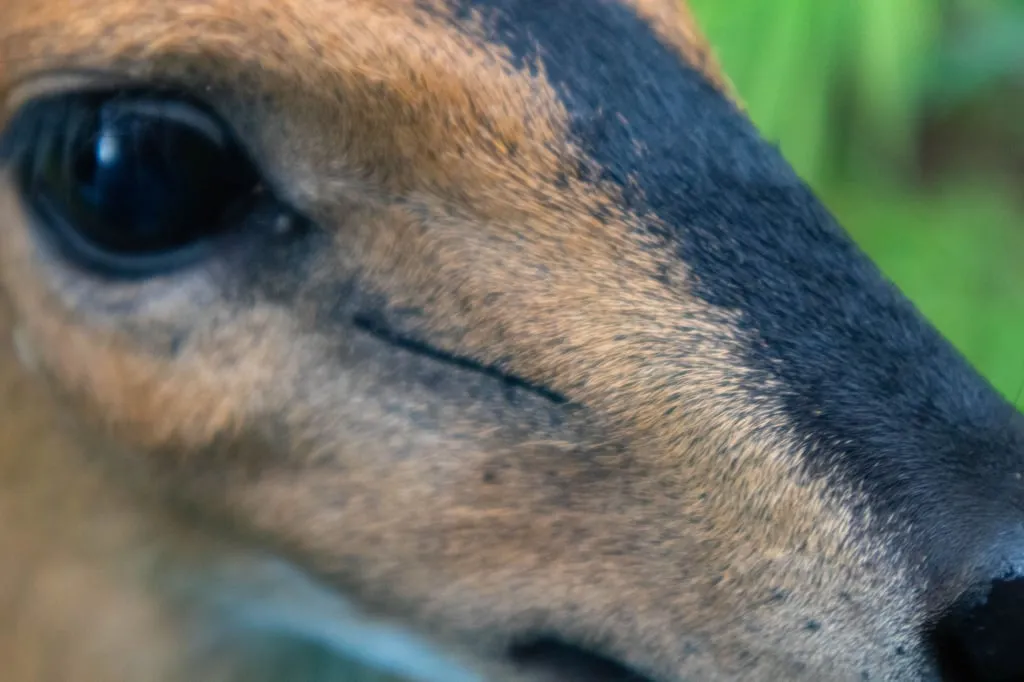
Duikers also have glands between their split hooves. They mark their territory with the secretions when rubbing their muzzles against branches and tree trunks. They also use excrement left on the borders of their territories for the same purpose.
How do duikers interact with each other?
These are solitary animals that do not allow intruders into their territory. When encountering individuals of the same species, the duiker will defend its territory. An exception is made during the breeding period when a male and female temporarily form monogamous pairs. Group formation with 2–3 individuals is also possible.
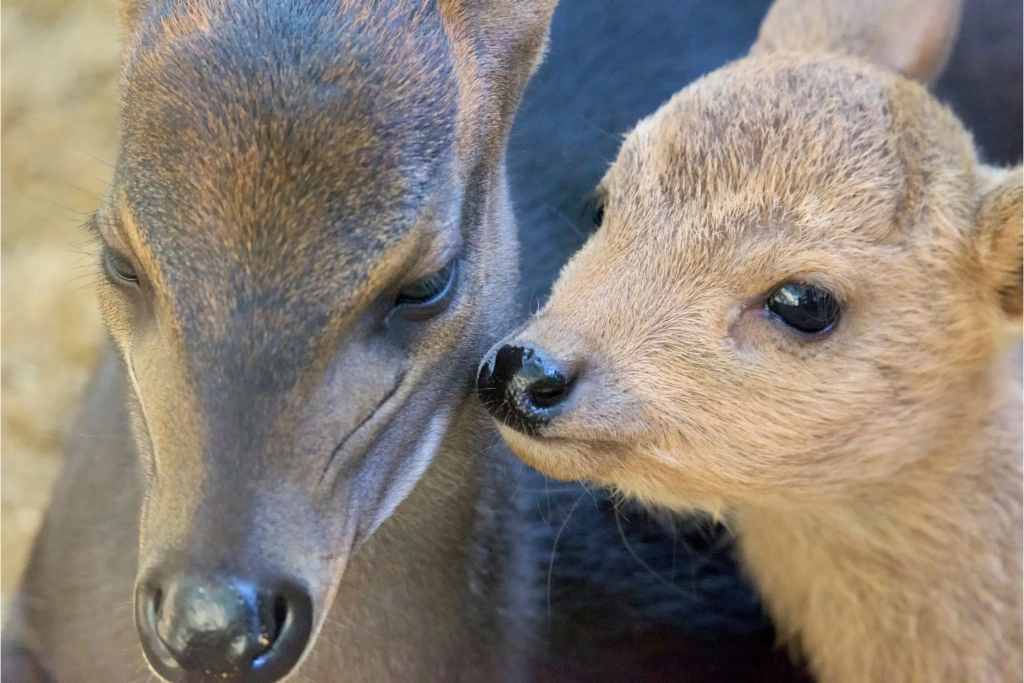
In cases where representatives of different duiker species coexist in one forest but are approximately the same size, they peacefully divide the territory, choosing different habitats and different times of activity. Some species are active during the day, while others are active at night. An exception is the yellow-backed duiker, which is active both day and night.
What do duikers eat?
Duiker antelopes are primarily herbivores. They feed on leaves, grass, shoots, flowers, seeds, buds, mushrooms, and fallen fruits. They find food on the ground or at a low height reachable with their mouths.
Interestingly, duikers follow birds, bats, and monkeys feeding in the upper parts of trees. They benefit from the fruits accidentally dropped to the ground by these animals. During the rainy seasons, many duikers frequently do not need drinking water, instead obtaining all fluids from fruit and plants.
There is evidence for many duiker species suggesting that these antelopes can also be carnivorous. Apart from the occasional consumption of insects and bird eggs, they sometimes hunt for small birds, frogs, and rodents. Some duikers have been observed eating carrion.
Who hunts duikers?
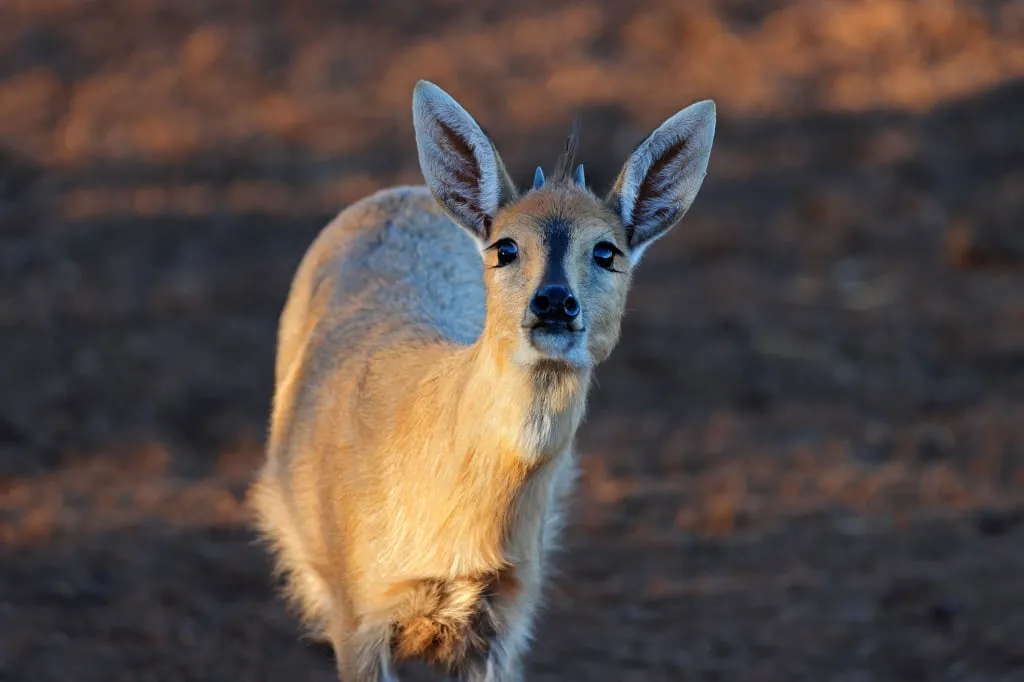
The main enemy of these antelopes is humans. Representatives of larger species suffer especially due to the possibility of supplying meat to people. All species lose their habitats due to deforestation, the expansion of agricultural land, and creeping urbanization.
Natural enemies for duikers include leopards and other felines, pythons, monitor lizards, crocodiles, jackals, African wild dogs, monkeys, and birds of prey.
Where to see duikers in their natural habitat?
You can get to know and observe these small antelopes on safari. You are almost guaranteed to encounter the bush duiker in any of Tanzania's national parks by joining a tour with Altezza Travel .

By the way, we have an interesting tradition – we name our safari programs after different antelopes. All programs 'include' African antelopes from the tiny dik-dik to the huge eland . The longer and more interesting the program, the larger the antelope it is named after.
There is also a wonderful safari program called 'Duiker' . It includes a visit to Lake Manyara Park and the Ngorongoro Conservation Area, one of the best places in Tanzania where you will see many animals in a short time. It is quite likely that you will also encounter the common duiker. However, we do not limit you to a two-day tour; you can choose any. Strive to explore the wild nature of Africa through your own experience – it's very interesting!

Yuri, a full-time researcher and writer at Altezza Travel, has been living in Tanzania since 2019. He has explored many of its lesser-known destinations, including Kitulo and Rubondo National Parks, Lake Victoria, Zanzibar, and many other historical, natural, and archeological sites. His experiences in the Amani Forest and Ibanda–Kyerwa National Park have inspired him to become a passionate birder. Yurii is also an avid reader, delving into various volumes about Tanzanian culture and history. He regularly shares detailed articles based on his research and travels on our blog.


Duiker (Red)
The red duiker.
The red forest duiker, Natal duiker, or Natal red duiker is a small antelope found in central to southern Africa. It is one of 22 extant species form the subfamily Cephalophinae. While the red forest duiker is very similar to the common duiker, it is smaller in size and has a distinguishing reddish coloring. Additionally, the red forest duiker favors a denser bush habitat than the common duiker. The Natal red duiker is more diurnal and less secretive than most forest duikers, so therefore it is easier for them to be observed.
Red forest duikers have a body length of up to 1 m, a typical shoulder height of 43 cm, and an average mass of 14 kg. Both sexes have short, straight horns about 6 cm long, although in females they may be smaller in size. Towards the base, the horns have coarse rings and longitudinal striations, but they are smooth towards the tips. The longest recorded length of horns for the red forest duiker is 11 cm.
The red forest duiker is a rich reddish-brown in color, although the underparts are typically paler. The hairs on the chin, throat, and insides of the ears are commonly a shade of white. A tuft of reddish-brown and black hairs grow between the horns, and the tail has a white tip.
A notable characteristic of the Natal red duiker’s appearance is its hunched back, with front legs shorter than the hind legs. These longer hind legs are in a crouched position, which serves as an advantage when the duiker senses danger and needs to flee by allowing the individual to leap quickly into nearby brush.

Behavior and social organization
Red forest duikers tend to roam singly, in pairs, or small family groups, and it is rare to see a group of more than three individuals. The cry of red forest duikers is rather distinctive, loud, and penetrating, sounding somewhere between a snort and a whistle. The call of a duiker becomes a throaty cry when the animal is distressed. When the duiker has been spotted by a predator, it will first freeze, and then bound away with the characteristic duiker diving motion into the safety of the thick brush.
- Hunters Namibia Safaris
- Hunting Area
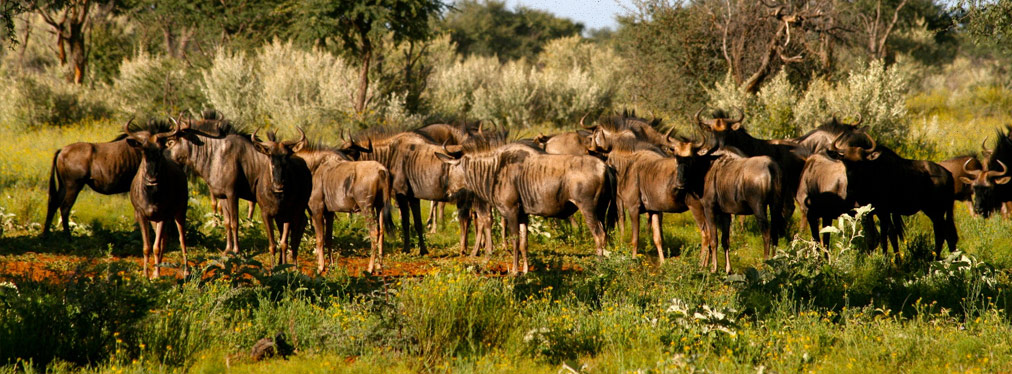
- Introduction
- Fees & Trophies
- Equipment & Clothing
Hunters Namibia Safaris’ trophy quality is consistently outstanding due to our exclusivity and limited number of hunting clients hosted annually. Our records show that 92% of trophies taken over the past 30 years qualify for the top half of the SCI Record Book, although not all hunters chose to register them. Due to the huge quantity as well as the excellent quality of game on our land, (80 square miles) you can hunt truly selectively. On average, our hunting clients take one trophy per day, but no limit is placed on the number of species that you may take during a specific safari period.
A minimum period of 7 full hunting days is required, however, 10 days is recommended. Cheetah, Leopard and Sable hunts necessitate a 14-day safari. We do not suggest short safaris as much of the pleasure of hunting, as well as appreciation of the environment, is lost during a high-pressure safari.
One of our qualified and experienced Namibian Professional Hunters will accompany you on your hunt at all times, and may do so with a maximum of two hunting clients per P.H. at a time. No more than 30 hunting clients are accepted per season. Your booking will reserve you and your party the exclusive use of the facilities with no other groups in camp.
While hunting, classic, open Toyota Land Cruiser vehicles are used, but all stalking is done on foot – we focus absolutely on fair chase, ethical hunting. All vehicles are in excellent running condition and completely equipped with First Aid kits, tools, two way radios, refreshments and electric winches. Our professional team of skinners does outstanding field preparation of the trophies in order to prepare them for delivery to a local freight agent or taxidermist. All the meat from the hunt is utilized.
The Namibian trophy-hunting season runs from the 1st of February to the 30th of November annually.
Should you wish to discuss your dream safari with them, please do so now by contacting our representative Corinna Slaughter at 205-969-850 or [email protected]
SAFARI PRICES FOR THE SEASONS
1st February – 30th November 2022 (Subject to change & valid for 2022 only)
PLAINS GAME DAILY RATES
1 Client per P.H.: U.S. $595 per hunter/night. 2 Clients per P.H.: U.S. $495 per hunter/night. Observers: U.S. $280 per observer/night. Children under 12 years: U.S. $180 per child/night. (Above daily fees excludes the 15% Government V.A.T.). Customized Photographic Safaris quoted on request.
Oryx (Namibian)
Roan (Southern)*
Sable (Southern)*
Dik-Dik (Damara)*
Springbuck (Kalahari)
Duiker (Common)
Eland (Cape)
Waterbuck (Common)
Hartebeest (Red)
Wildebeest (Black)
Impala (Black-faced)
Wildebeest (Blue)
Impala (Southern)
Zebra (Burchell)
Klipspringer
Zebra (Hartmann)
Kudu (Southern)
Quoted Fees Include
- Full accommodation and meals during your Safari.
- Local wine and beer with dinner
- Soft drinks
- Daily laundry service.
- The use of hunting vehicles
- The service of Professional Hunter, tracker and skinners
- Transport to and from the airport and during the hunt
- Field preparation of trophies, and delivery to freight agent
- All government permit fees
Quoted Fees Exclude
- Weapon hire for H.N.S. rifles
- Packing, dipping and shipping costs of trophies
- Alcoholic beverages (Prices available on Request)
- Transport at client’s request @ US$ 2.00/Km.
- Hotels and air fares before and after the Safari
- Gratuities you may wish to leave for the staff
- Wiring fees
Your Safari is confirmed only when Hunters Namibia Safaris receives a signed Safari Contract, along with a deposit of 50% of the daily fees for designated length of the Safari. The balance of the daily fees is payable 6 months prior to the commencement of your Safari. The trophy fees and the fees for excluded services (i.e. transportation, alcoholic beverages etc.) are payable on completion of the Safari, before departure. All payments are to be made in U.S. dollars unless otherwise arranged.
We recommend dark green clothing in medium or heavy cotton. Please bring warm clothing if your safari falls in the period June to August. The remainder of the year you can hunt in shorts and short-sleeved shirts, but you will still require a warm jacket for early morning and evenings. Three sets of clothing will be sufficient for your safari. Rubber soled boots in a dark brown colour, which have been “broken in” before your arrival, are recommended. A pair of comfortable house shoes for the evenings will come in handy. A broad rimmed olive green safari hat is a must. Be sure to bring a bathing suit during the summer months.
Do not forget your camera, as well as ample SD cards, and batteries. A good pair of 8 X 40 binoculars is essential.
FIREARMS & AMMO:
As stipulated in the Namibian hunting Legislation, smallest calibre allowed on planes game hunts is 7mm, and the minimum muzzle energy of 1350 Joule for Springbuck, Duiker etc., 2700 Joule for Red Hartebeest, Wildebeest Greater Kudu, Gemsbuck, Cape Eland etc., and 5400 Joule for Buffalo, Elephant, Rhino etc.. We strongly recommend a calibre of .300 magnum or larger, fitted with a 6X40 scope, for plains game. This is, however, a personal matter and we suggest that you use whatever rifle (of adequate calibre/muzzle energy) you are most familiar and comfortable with. We recommend the heaviest weight of ammo for your calibre in Nosler partition. If you are a keen wing-shooter, bring your favorite shotgun and approximately 50 shells in #7’s. The Namibian authorities do not place any restrictions on the temporary importation of hunting rifles. A maximum of 100 rounds per weapon may be imported. You will receive a form to fill out on your arrival and the permit will be issued at the airport – the process is uncomplicated.
CLICK HERE to download the Namibia Temporary Forearm Importation Form. Should you prefer to travel without weapons, we have a fine selection of quality rifles and shotguns in camp for hire.
Please Note: No pistols, revolvers, automatic or semi-automatic weapons may be imported into Namibia for hunting purposes. Please also note that ammunition may not be transported in your rifle case. As you may be in transit through other countries it is important to note that some laws require ammunition to be transported in a lockable metal container. This is not a requirement in Namibia.

Connect with us
Duiker Safaris
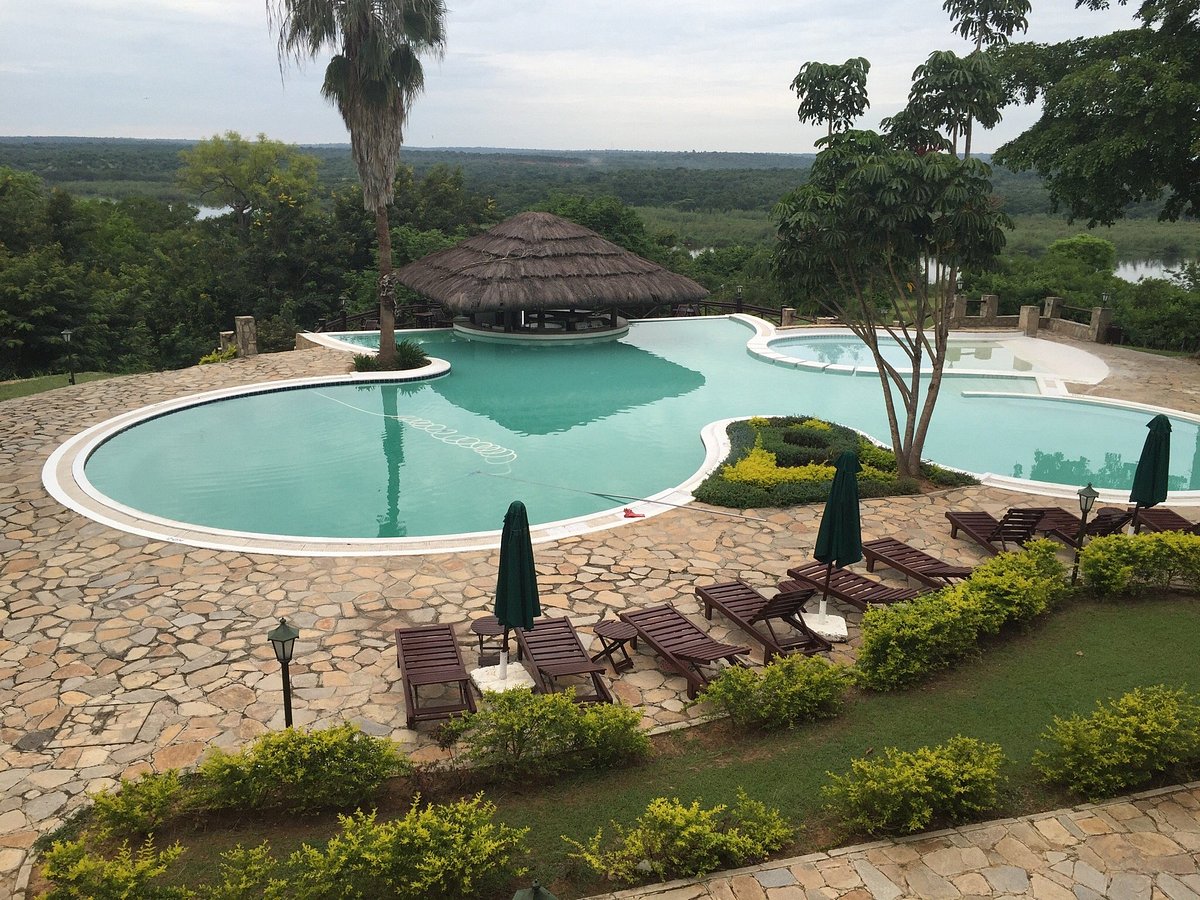
- See all photos
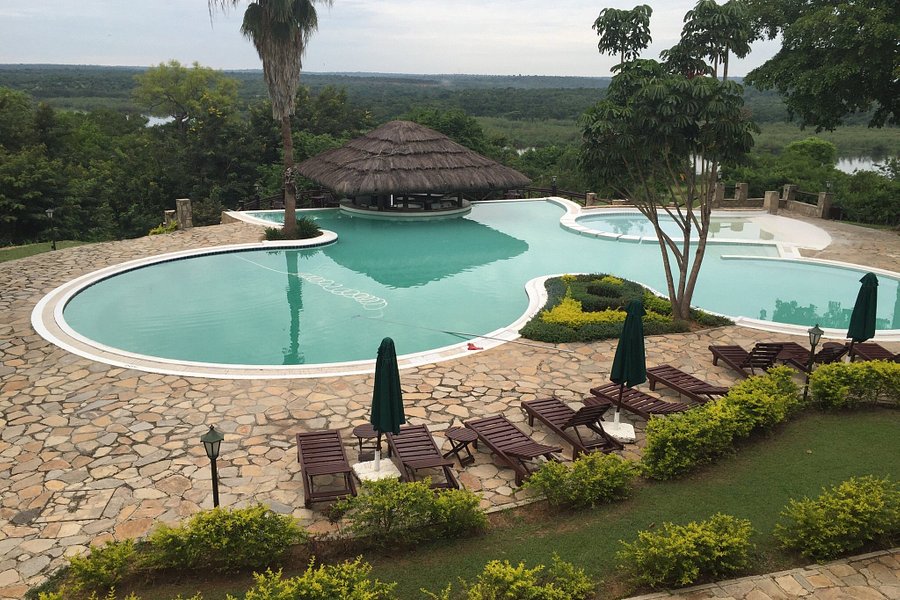
Similar Experiences

Most Recent: Reviews ordered by most recent publish date in descending order.
Detailed Reviews: Reviews ordered by recency and descriptiveness of user-identified themes such as wait time, length of visit, general tips, and location information.
Duiker Safaris - All You Need to Know BEFORE You Go (2024)

IMAGES
COMMENTS
DUIKER SAFARIS NAMIBIA. Duiker Safaris - the premier Namibia hunting outfitter is proud to offer the highest quality of plains game hunting, Leopard hunting in Namibia. We have over 20 plains game hunting species such as Kudu, Eland, Oryx to name a few. At Duiker Safaris, we take considerable pride in the manner in which we conduct our traditional African hunting safaris, as well as bow ...
Duiker Safaris offers traditional and bow hunting safaris for over 20 plains game species and leopard in Namibia. See hunting trips, prices, reviews and contact information on BookYourHunt.com.
Duiker Safaris. Location. Contact Information. Address. Farm Duiker 929 Grootfontein. Phone. 067232626. Email. [email protected]. Related Listings. Popular. JFG Tours and Safaris CC. TPH01295. ... Namibia Tourism Board uses cookies on this website to give you the most relevant experience by remembering your preferences and repeat visits. By ...
Omatako Hunting Trails offers rifle and bow hunting for various game species, including leopard, in Namibia. The hunting lodge provides luxury accommodation with views of the open plains and a waterhole.
Learn about the Duiker, the biggest of Namibia's "small 4" antelope, and how to hunt it with Jan Oelofse Safaris. Find out where to spot them, what they look like, and how big their horns are.
The common, or grey, Duiker is a tiny, shy antelope with only the males having short horns. The common name refers to a characteristic habit of taking off at high speed in a series of diving jumps when alarmed. Duiker browse a wide range of broad-leaved forbs, trees and bushes, they also eat fruit, pods and seeds, roots, bark, flowers, fungi ...
Everything you need to know about a free-range Duiker hunt in Namibia (Africa) determine a „past prime" male calibre cost habitat farms ... accommodation in apartments or fully equipped safari tents. Find hunting trips. Indigenous Namibian game species at a glance. Discover which indigenous, free-roaming game species are found in Namibia ...
Read reviews from hunters that previously hunted with 'Duiker Safaris'. BookYourHunt is a #1 online marketplace where hunters can discover, book, and enjoy hunting trips directly from outfitters around the world. ... Duiker Safaris Namibia. 9.7 Contact outfitter. 9.7. Review score Based on 8 reviews Bryan Uruguay. 10.0 of 10 Excellent hunting ...
Duiker Safaris and Tours. 47 likes. We allow visitors to tailor make their own tour to Kruger National Park. You have a choice of a range of camps, food, drinks and daily game drives; ect
Visit Zana Botes Safari, a premier outfitter in Namibia's heartland. Are you looking for a thrilling Duiker Hunting experience? Visit Zana Botes Safari, a premier outfitter in Namibia's heartland. ...
The common duiker, also known as the grey or bush duiker, is a small antelope found in everywhere in Africa south of the Sahara, excluding the Horn of Africa and the rainforests of the central and western parts of the continent. Generally, they are found in habitats with sufficient vegetation cover to allow them to hide—savanna and hilly ...
Jamy Traut is a well-know and respected outfitter based in Namibia. Jamy Traut Hunting Safaris is a family-run operation dedicated to providing a small number of clients with an unequaled opportunity to hunt Africa's great game. Baboon, cat, Fox, Rhino, Reedbuck Wildebeest, Tsessebe, Kudu, Roan and other species ... a Duiker safari can often be ...
Common Duiker are small, elusive antelopes found in the forests and savannas of Africa. They have a distinctive reddish-brown coat, with white underparts and legs. ... Jamy Traut is a well-know and respected outfitter based in Namibia. Jamy Traut Hunting Safaris is a family-run operation dedicated to providing a small number of clients with an ...
Just below the Khomas-Highland Escarpment, nestled in a Valley bordered by Granite Mountains, and about halfway between Swakopmund and Windhoek along the C28 Gravel road, you will find Farm Donkerhuk West. A family-owned farm covering an area of 7614 hectares, offering two Exclusive Campsites ( Andi's Camp and the new " Duiker's Den ...
The average weights, coloration, and ear size of the gray or common duiker vary with geographic location. Females generally weigh 2-4 kg more than males in a given region. On average, they are 60 cm in height at the shoulder and are 100 cm in length. Males have horns, which are spikes 7-18 cm and are heavily grooved at the base. Females usually ...
Namibia. Captivating in scale, breathtakingly beautiful and almost dauntingly wild. Kenya. Dance with the Maasai, kiss a giraffe, dive over coral reefs. Zambia. ... and the various places you'll stay on the Duiker Safari. Everything we do is completely tailor-made so while this is an idea which works well, we'll always design an itinerary ...
Onduri Hunting Safaris lodge is located 450 km NW of Windhoek on a 13,000 ha farm, near Outjo and the Etosha National Park. Due to its location and hilly landscape, we offer kudu, springbuck, blue and black wildebeest, warthog, hartebeest, duiker, Impala and steenbuck as well as cheetah and leopard hunts. Other predators like Hyena ext can also ...
Farm Duiker 929 Grootfontein Namibia. Hunting area: Our hunting area has an area of around 40,000 ha. Game: All Plains game species . Special: Eland Hunt. Accommodation: Hunting Camp. Activities: Visits of Etosha National Park and in a Bushmen village. Contact: Duiker Safaris P.O. Box 252 Grootfontein Bennie Boshoff +264 81 255 7161 ...
The blue duiker is the smallest among duikers. Its height matches that of an average dik-dik—around 30-40 cm (12-16 in) at the shoulder. The weight of both antelopes is also comparable, starting from 3 kg (6.6 lbs) in adults. The blue duiker - the tiniest representative of duikers.
The red forest duiker, Natal duiker, or Natal red duiker is a small antelope found in central to southern Africa. It is one of 22 extant species form the subfamily Cephalophinae. While the red forest duiker is very similar to the common duiker, it is smaller in size and has a distinguishing reddish coloring. Additionally, the red forest duiker ...
Hunters Namibia Safaris' trophy quality is consistently outstanding due to our exclusivity and limited number of hunting clients hosted annually. ... Duiker etc., 2700 Joule for Red Hartebeest, Wildebeest Greater Kudu, Gemsbuck, Cape Eland etc., and 5400 Joule for Buffalo, Elephant, Rhino etc.. We strongly recommend a calibre of .300 magnum ...
About. Duiker Safaris offer Adventure Gorilla safaris in Both Uganda and Rwanda's National parks. Besides these joyful Gorilla Trekking Tours we are accustomed to Chimpanzee trekking safaris, wildlife Safaris to Uganda, Rwenzori Mountain Adventurous Climbing. And Car hire & rentals services, Bird- watching trips, Fishing Trips on Lake ...